The QN80F is the first "eighty" from Samsung to enter the series of televisions with Mini LED backlighting. And it does this very well. Although the number of dimming zones isn't particularly impressive, the quality of black levels is solid, and combined with high brightness, it allows for a very decent picture in HDR content. Additionally, there's a 144Hz panel that ensures excellent motion fluidity, and the set of gaming features – VRR, ALLM, Game Motion Plus – makes the QN80F a model practically designed for those gaming on consoles or PC. The television operates quickly and responsively, and the Tizen system runs like lightning – whether you're searching for apps or switching sources. Is there anything to criticise? Of course, as always – there are shortcomings in the system (like USB recording), there's no DTS support, and Mini LED isn't without its limitations. But the QN80F is a fantastic television for everyday use – versatile, refined, and... with great pricing potential. Because looking at the history of this series, we can expect that this "eighty" will mix things up significantly once it hits the first sensible promotions. At that point, it could be virtually unmatched in its price range – especially if Samsung resolves the minor teething issues.
- Matching (Score)
- Our verdict
- TV appearance
- Where to buy
- Contrast and black detail
- HDR effect quality
- Factory color reproduction
- Color reproduction after calibration
- Smoothness of tonal transitions
- Image scaling and smoothness of tonal transitions
- Blur and motion smoothness
- Console compatibility and gaming features
- Input lag
- Compatibility with PC
- Viewing angles
- TV efficiency during daytime
- Details about the matrix
- TV features
- Apps
- Playing files from USB
- Sound
Samsung QN80F vs Philips OLED820
Direct compare
QN80F
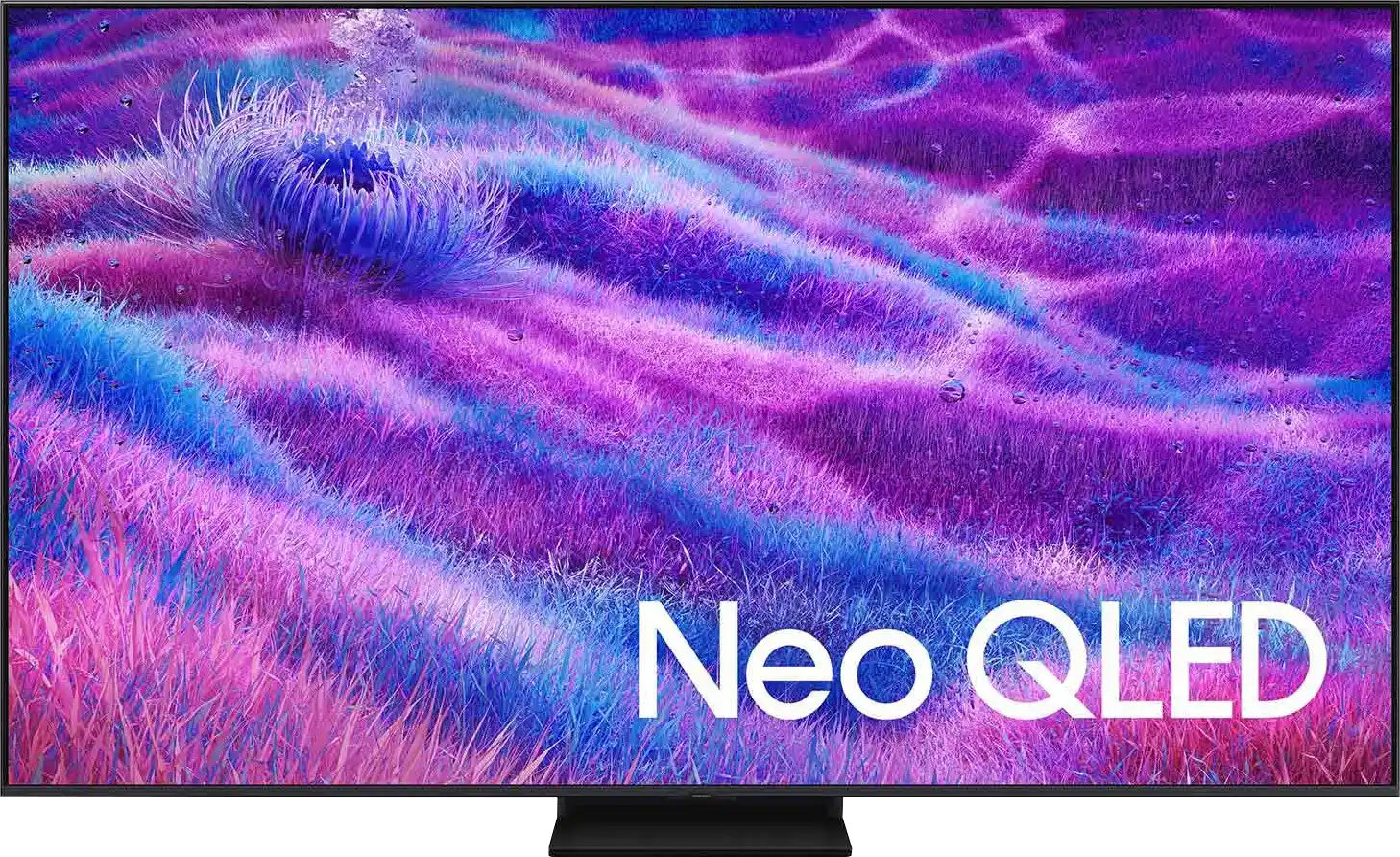

Panel type: LCD VA
Resolution: 3840x2160
System: Tizen
Model year: 2025
Complete the survey to find out the result

Panel type: WRGB OLED
Resolution: 3810x2160
System: Google TV
Model year: 2025
Complete the survey to find out the result

Overall rating
7.3
8.0
Movies and series in UHD quality
6.9
8.3
Classic TV, YouTube
6.8
8.6
Sports broadcasts (TV and apps)
6.7
8.5
Gaming on console
8.5
9.4
TV as a computer monitor
8.8
6.5
Watching in bright light
6.6
5.7
Utility functions
7.7
6.8
Apps
8.7
9.6
Sound quality
6.7
7.7
Complete the survey to find out what fits your preferences
Advantages
Impressive blacks and contrast - VA panel combined with MINI-LED backlighting.
Great brightness - up to 1000 nits in HDR
Fast and responsive panel - 144 Hz
Rich support for gamers - 4xHDMI 2.1, VRR, ALLM, GameBar, Game Motion Plus
Very good usability in daylight
Advanced Tizen operating system
Simple operation
PiP function
Ideal contrast and black thanks to the WOLED panel
High HDR brightness (up to 1300 nits) and wide coverage of the DCI-P3 colour palette (99%)
Support for multiple HDR formats including Dolby Vision and HDR10+
Great motion smoothness, no motion blur, refresh rate up to 144 Hz
Full support for gamers: HDMI 2.1 (2 ports), VRR, ALLM, HGiG, Dolby Vision in games, low input lag
Ambilight that has a real impact on the perception of the image and distinguishes the television from the competition
GoogleTV system with a vast application base and excellent voice assistant
Extras including: Backlit remote control and swivel stand
Support for Dolby Atmos and DTS:X audio formats
Disadvantages
No support for DTS format – a limitation when connecting a home cinema
No recording function to USB
Relatively few dimming zones
Issues with the HGiG function (for gamers) – the update removed this option*
Only two HDMI 2.1 ports (with 2 consoles and a soundbar we are forced to "juggle" with the cables)
Lack of many classic "TV" functions, e.g. recording to USB or PiP mode, infrared remote may be irritating
Slight issues with colour blending (much better than last year but far from the competition)
Problems with font readability when working with PC (lack of full support for Chroma 4:4:4)
Our verdict
Philips OLED820 is a very successful and significant step forward compared to last year's model, the OLED 819. For many people, the main reason for purchase will, of course, be Ambilight: the multi-coloured lighting system that distinguishes Philips televisions from the competition. It's not hard to see why, as it made a huge impression on us as well. It's not just an impressive gadget, but a real addition that can transform the experience of the content being viewed and add depth to it. However, Ambilight should not overshadow what the OLED820 offers as a screen. We have almost infinite contrast, high brightness in HDR films, and excellent colour reproduction, which improves even further after slight tweaking or professional calibration. This set guarantees one of the best images that can currently be found on the market, and on top of that, we are aware that the television offers something unique and unattainable anywhere else. It is also a device that performs well in gaming. The 144 Hz panel and HDMI 2.1 ports open up access to the full potential of next-generation consoles, and the low input lag ensures that gameplay is exceptionally responsive. The operating system – Google TV – also deserves praise. It is a much better solution than the proprietary Titan OS found in lower models of Philips, such as the OLED770. This is a serious argument for paying extra for this model. A larger library of applications, a more efficient voice assistant, and fewer system errors translate into a distinctly better daily experience. Of course, the Philips OLED 820 is not free from minor flaws – there are some shortcomings in the software, and certain functions could be better refined. Nevertheless, the overall presentation is very solid. Perhaps the OLED820 is not a revolutionary television, but it is a very successful and well-balanced proposition in Philips's offering. It combines excellent image quality, a full set of functions for gamers, and a unique addition in the form of Ambilight. If you are looking for a solid OLED in the mid-range that, aside from good image quality, offers something distinctive and simultaneously exceptional, the OLED820 should be high on your shopping list.
TV appearance
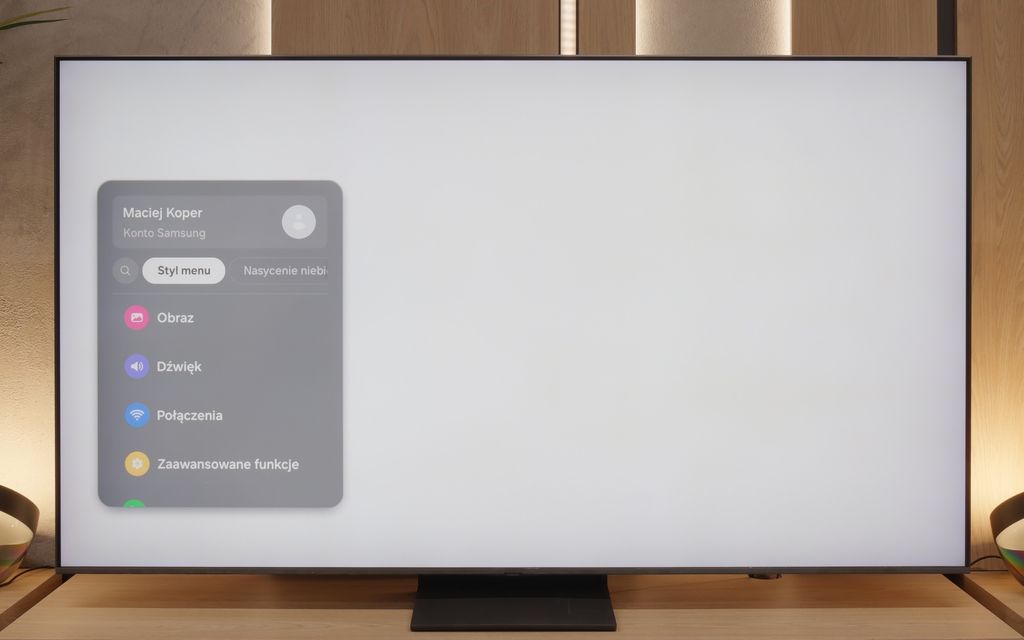
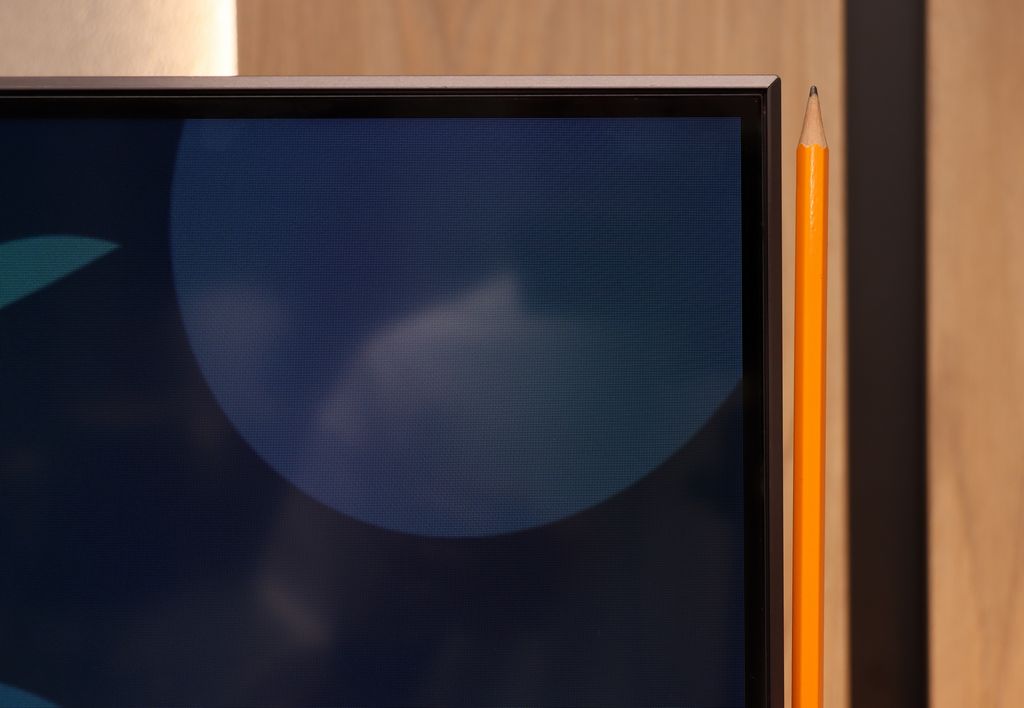
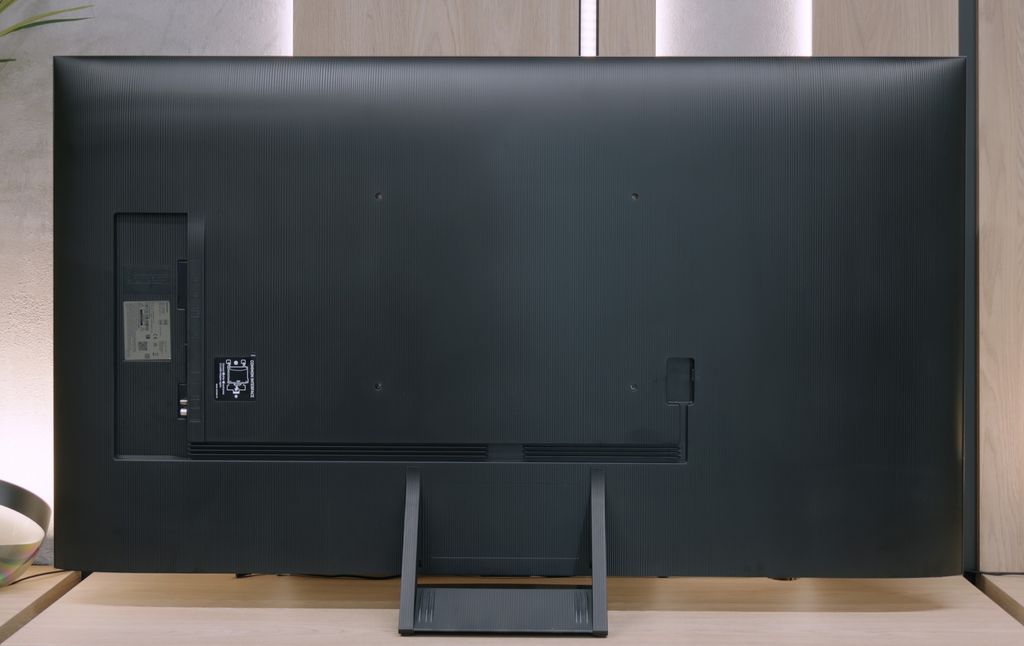
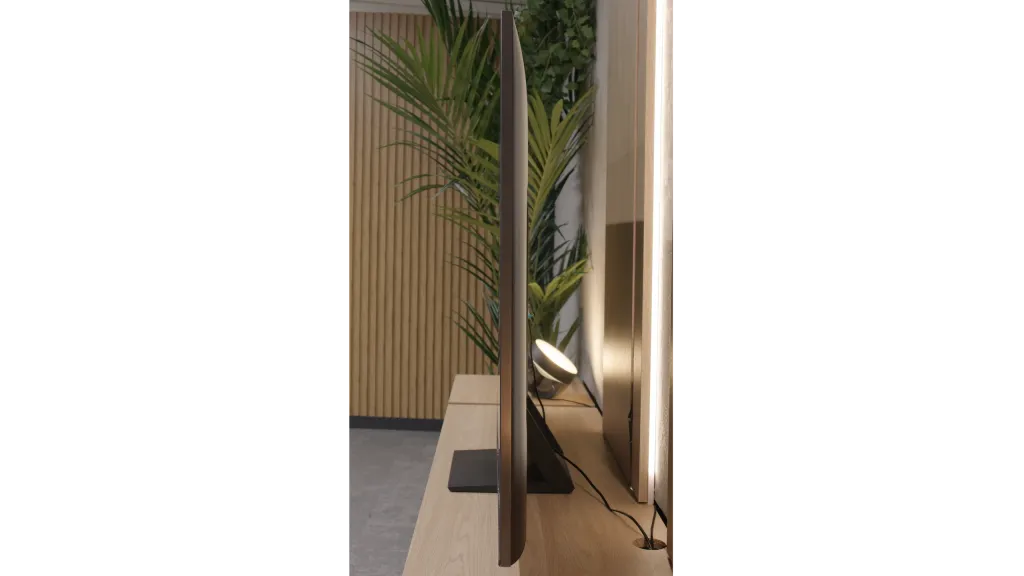




Contrast and black detail
6.8/10
10/10
Local dimming function: Yes, number of zones: 88 (8 x 11)
Contrast:

Result
34,100:1

Result
8,200:1

Result
32,500:1

Result
4,550:1

Result
3,800:1

Result
∞:1

Result
∞:1

Result
∞:1

Result
∞:1

Result
∞:1
Halo effect and black detail visibility:
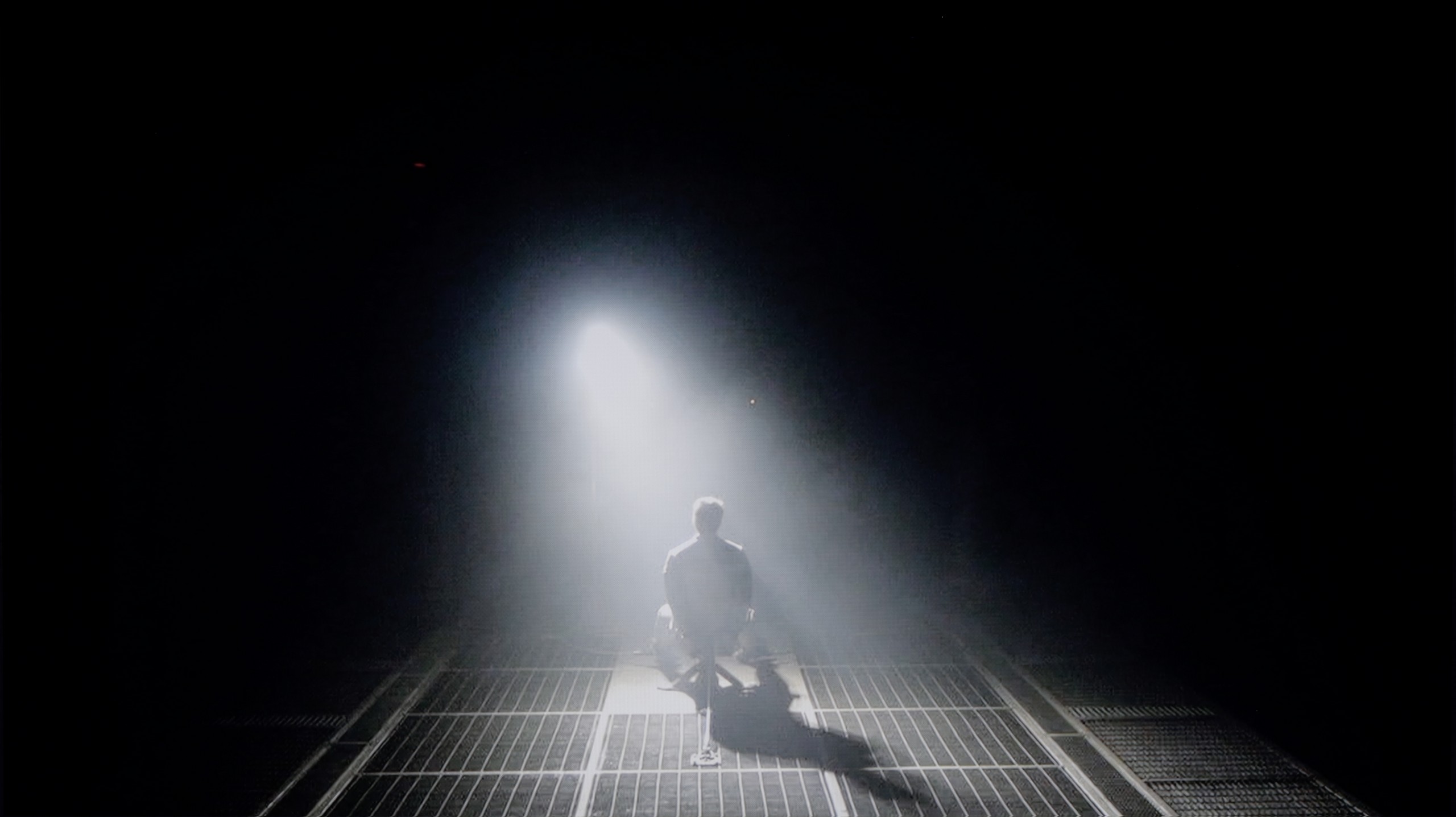

QN80F is a representative of the Neo QLED series, meaning it is a television with Mini LED backlighting. Unlike its cheaper cousin, the QN70F model, the diodes here are placed directly behind the panel (rather than at the edges), which gives it a solid advantage right from the start when it comes to contrast control. In the 65-inch variant we tested, we counted 88 dimming zones – a result that may not be particularly impressive, but as it turned out, sufficient to achieve quite decent results.
In tests based on scenes from films such as Oblivion and The Meg, the QN80F performed well – blacks were deep, and the overall image consistency was visually appealing. However, in more demanding moments (e.g., scenes with a large number of bright details on a dark background), a halo effect appeared. This is where the limitation of the number of zones becomes evident – bright elements could bleed into one another, and some details in the dark areas lost visibility. In one scene featuring a helicopter (The Meg), we even noticed slight brightness flickering, as if the television was trying its best to maintain detail visibility at the expense of black depth.
However, these issues are not exclusive to this model – halo effects or drops in contrast during very complex scenes are challenges faced by most Mini LED televisions, even the more expensive ones. In its class, the QN80F performs positively and offers significantly better contrast than the QN70F model with edge backlighting. For most users, this will be a level more than sufficient – although not perfect.
Contrast and black are the domain of OLEDs, and the Philips OLED820 is no exception. The applied WOLED panel from LG Display functions just like in the LG C5 models or the Samsung S90F, providing exactly what we expect – perfect black and infinite contrast. Whether we are watching challenging scenes full of intricate details or simpler shots immersed in uniform black, the television always performs flawlessly. It separates light from darkness with surgical precision, creating an extraordinary sense of depth in the image. And while one can debate various technologies, in this category, OLED simply reigns supreme, and the Philips OLED820 only confirms this rule.
HDR effect quality
5.8/10
7.5/10
Luminance measurements in HDR:

Result
799 nit

Result
533 nit

Result
717 nit

Result
245 nit

Result
656 nit

Result
1035 nit

Result
1235 nit

Result
1356 nit

Result
1315 nit

Result
521 nit
Scene from the movie “Pan” (about 2800 nits)


Scene from the movie “Billy Lynn” (about 1100 nits)


Static HDR10


Dynamic: HDR10+
Dynamic: Dolby Vision


HDR luminance chart:
Philips OLED820
Luminancja HDR
Luminance of RGB colors
Samsung QN80F
Luminancja HDR
Luminance of RGB colors
QN80F is quite a bright screen – in synthetic tests, it achieved nearly 1000 nits, which allows for justified expectations regarding HDR content. And indeed, in many scenes, the television can truly shine. Sequences with a lot of light – like shots from the film Life of Pi or wide, bright surfaces in The Meg – look impressive. Brightness remains around 700 nits, which provides a solid effect, sufficient to feel the true "HDR magic." Unfortunately, not every scene looks that good. In materials with small, bright details on a dark background, such as in Sicario 2, the television has issues – it can significantly dim certain elements, sometimes to the point where they disappear from the image. This is the result of a limited number of dimming zones, which forces the device to make compromises: either maintain inky blacks or sacrifice some detail. QN80F usually chooses the former. As a consolation, there is quite decent coverage of a wide colour gamut – DCI-P3 at 93%. This is not the highest score on the market, but it is more than adequate for most content on streaming platforms.
When it comes to HDR quality, the Philips OLED820 uses the same class of WOLED panel found in its biggest rivals – the LG C5 and Samsung S90F. This means we can expect really solid results. This year, mid-range OLED panels can exceed the threshold of a thousand nits, and the tested model reaches around 1300 nits in some films. This is an outstanding result, allowing the director's vision to be conveyed with immense precision, as this is the brightness range in which contemporary productions are mastered. Of course, there are situations where even the OLED820 has to compromise. Full-screen scenes filled with white, like those in the film The Meg, can drop brightness to 400–500 nits, which clearly weakens the effect. This is a characteristic of OLED technology that has yet to be fully eliminated. Despite this limitation, it is hard not to appreciate the HDR in this model – high luminance and a wide DCI-P3 colour gamut coverage of 99% make the image simply look fantastic.
Factory color reproduction
6/10
6.7/10


Factory Mode
After calibration


Factory Mode
After calibration
We test televisions always in the best available factory mode – in the case of the Samsung QN80F, this is the Filmmaker mode, and indeed, it is this mode that offers settings closest to the creators' intentions. However, this does not mean that everything looks perfect. In SDR content, the biggest problem turned out to be an unbalanced white balance – slight deficiencies in green and a noticeable excess of red led to discernible colour errors, one could even say a pinkish tint on the screen. This was well demonstrated in the colour checker test, where the colours 'escaped' beyond their target fields – to the extent that even a sensitive viewer's eye could catch this without the aid of a meter.
In HDR content, the white balance was much better, but another issue arose – brightness management. The EOTF curve resulted in an overly bright image for most of the time, which could affect the perception of contrast and caused the screen to subtly 'flicker' during dynamic light changes. We have already written more about this in the paragraphs on black levels and HDR. Fortunately, Samsung leaves the user with plenty of options. The QN80F offers a rich set of calibration options, including a 20-point white balance – therefore, we decided to check what this television is really capable of after proper calibration.
The colour reproduction in the factory settings really surprised us, and positively so. The Philips OLED820, switched to Filmmaker mode, immediately showed that it was quite well tuned in terms of colour. The white balance was relatively accurate, though there was a slight deficiency in the blue hue, which occasionally gave the image a slightly yellowish tint. However, this is not a flaw that particularly detracts from everyday viewing. A bigger issue arose with the brightness characteristics. The gamma curve clearly deviated from the ideal, with the line below the expected values, causing the image to be excessively brightened, and the colours looked as if they were covered with a light milky filter. This effect was also noticeable in tests using the Colour Checker pattern, where more pronounced errors appeared.
Color reproduction after calibration
8.3/10
9.3/10




After conducting a thorough calibration, it was possible to bring most of the image parameters to a really good level. The white balance in both SDR and HDR is nearly perfect – the picture is natural, neutral and devoid of the previously noticeable redness. The colours have gained depth, and the overall visual reception has become more pleasant and cohesive. It was also possible to partially master the brightness management, which in the factory version could be problematic. The EOTF chart shows that the television performs significantly better with brightness after calibration – there is no longer excessive dimming of certain elements. In films, it can still be noticed that the QN80F has a tendency to slightly brighten the smallest, light details – however, this is the effect of the device's design and the limited number of dimming zones. In short: not everything can be overcome, but what could be has been improved. After calibration, the QN80F makes a really good impression; it simply looks more mature and professional.
After calibration, both the Filmmaker mode and the gaming mode gained a lot. A slight adjustment of the white balance and an improvement in brightness characteristics produced excellent results in SDR content – the image looked almost perfect, natural, and very close to reference. In the case of HDR materials, the situation was similar, the colours were presented wonderfully, and it was hard to find anything to criticise. However, we noticed a certain feature, which we already pointed out when comparing scenes from the film Billy Lynn. The analysis of the EOTF curve showed that the television has a slight tendency to dim details in the blacks, so the darkest parts are not always displayed exactly as intended by the director. Nevertheless, the effect after calibration is stunning, and the OLED820 is emerging as one of the more interesting screens in its class. It just needs a little pampering, and there really is nothing to worry about.
Smoothness of tonal transitions
9/10
6.5/10




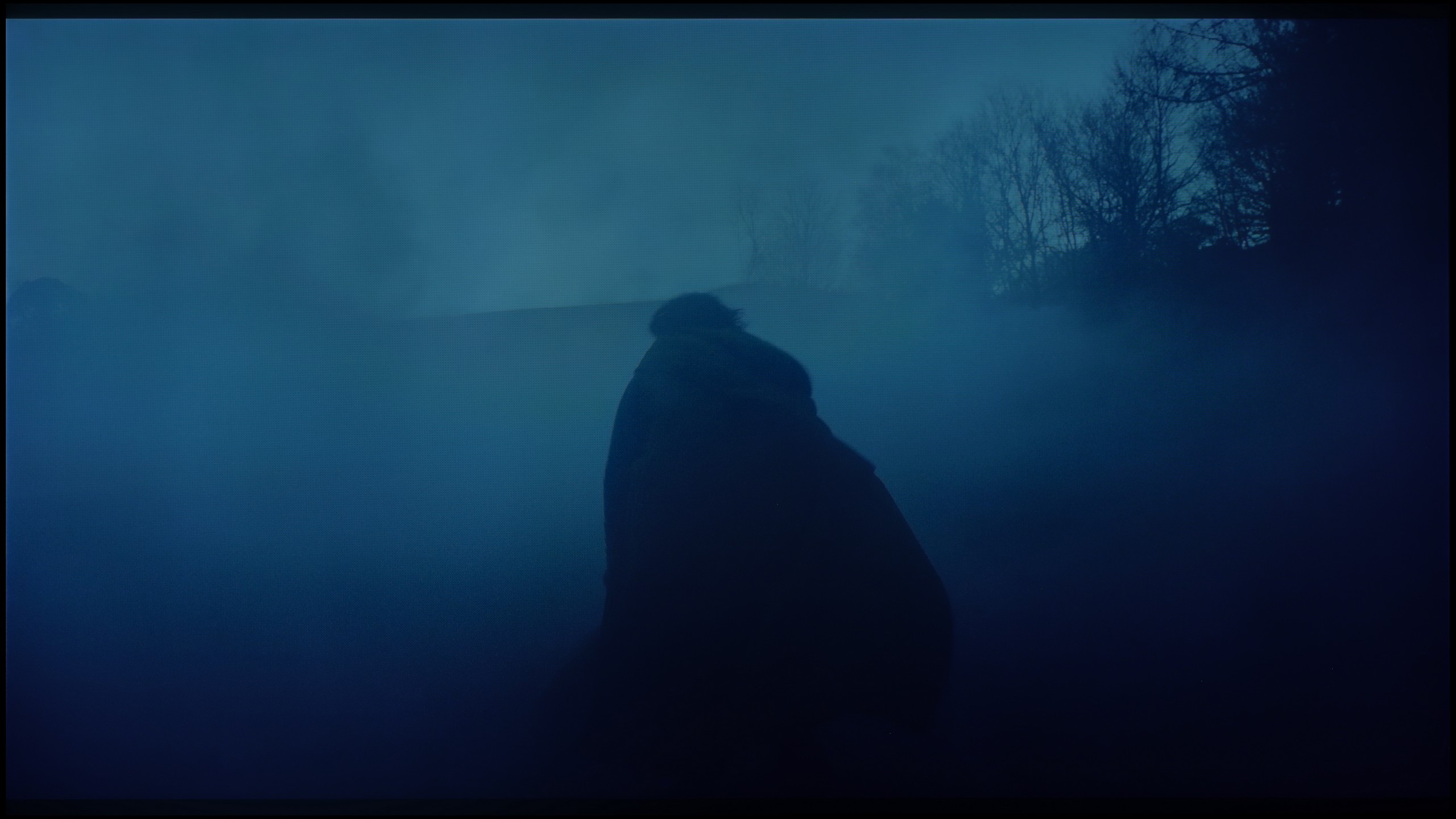

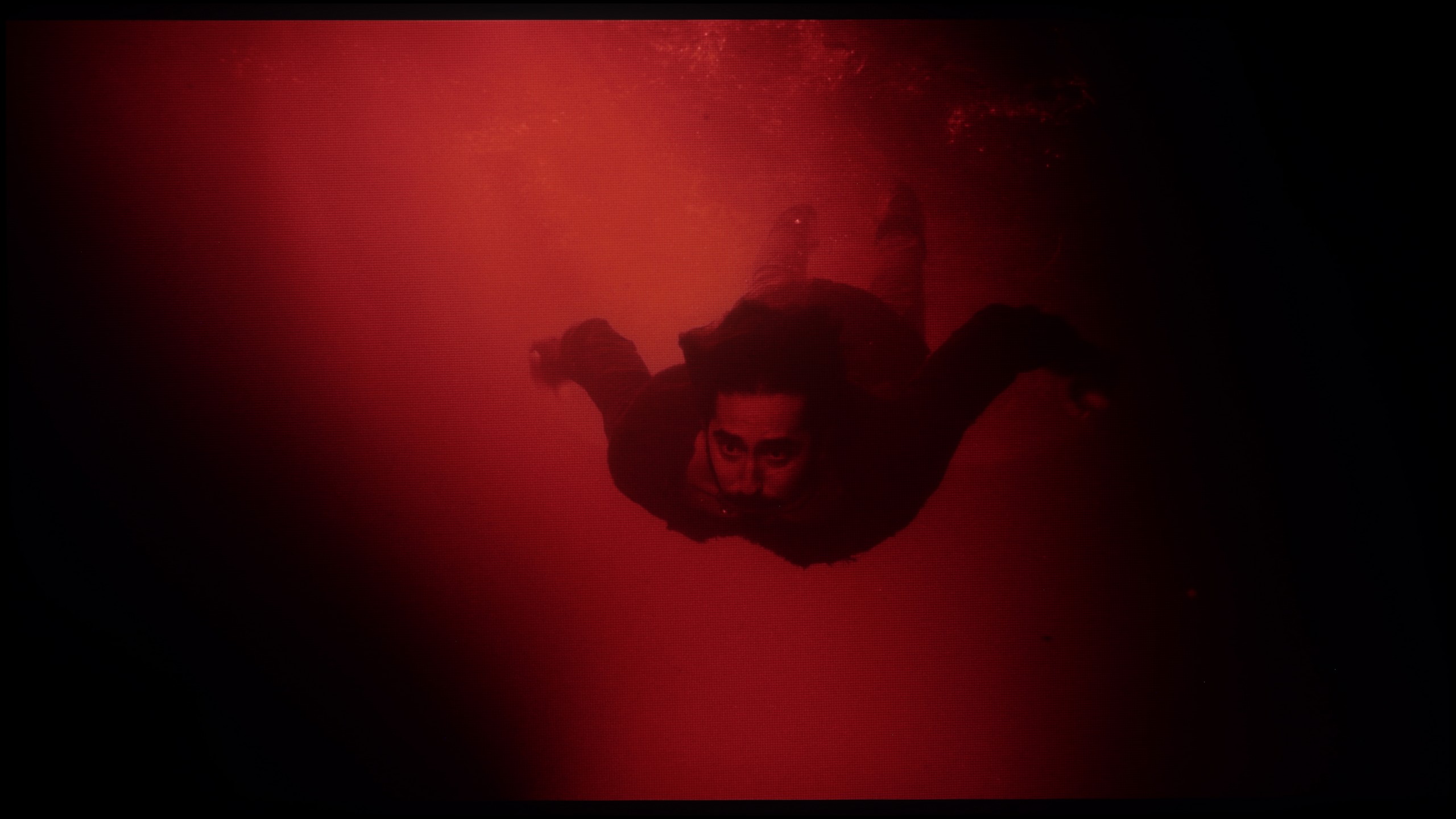





In this respect, the QN80F truly impresses. The transitions between colours are smooth, nothing is torn, and there are no annoying stripes in the sky or strange blotches in the shadows. Film scenes in darker tones performed particularly well – and this is where most televisions tend to struggle. If one is very determined, they may notice slight banding in the brightest sections, but that is really stretching for an issue. In everyday viewing, no one should have a problem with this. To put it plainly: the tonal transitions are so good that one can forget about them – and simply enjoy the film.
The fluidity of tonal transitions is unfortunately the Achilles' heel of the Philips OLED820. During testing, we noticed slight issues with colour blending – both in bright and darker scenes, one can perceive distinctive banding that detracts from the naturalness of the image. It must be acknowledged that compared to last year's OLED 819 model, there is a significant improvement, but nevertheless, the competition performs better in this category.
Image scaling and smoothness of tonal transitions
7/10
7/10
Smooth transition function
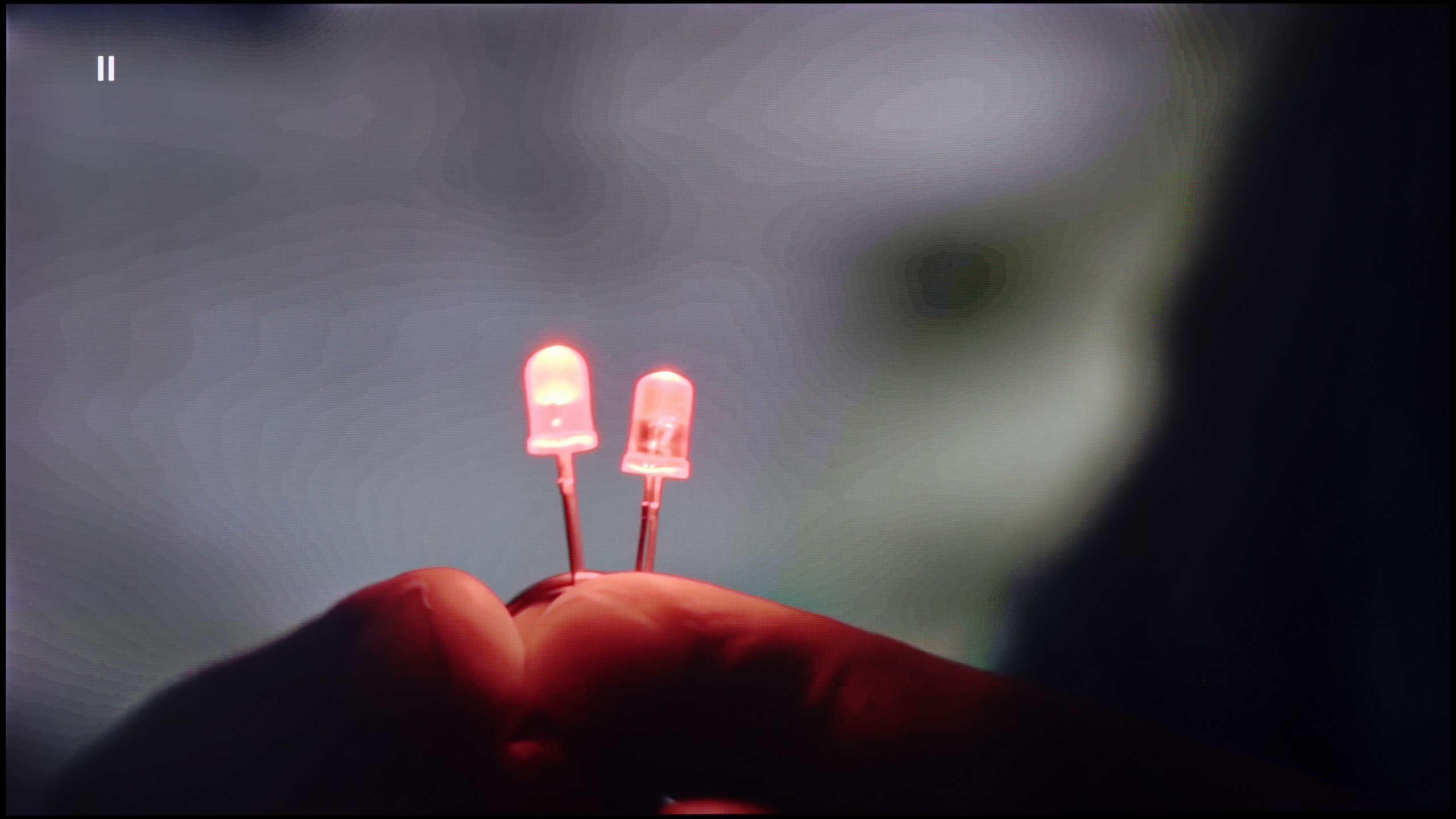

Image without overscan on the SD signal


If, while watching lower quality materials – for example from YouTube – we notice strange colour transitions or unwanted artefacts, it's worth checking the settings and turning on the noise reduction feature. In our opinion, the best setting is at “medium” – it effectively smooths out problematic colour transitions while not blurring the entire image too much. However, one must know this: this option tends to remove film grain. If someone cares about preserving this effect (e.g. in older films), it’s better to simply turn it off – regardless of the level, the grain always disappears.
When it comes to resolution scaling (or so-called upscaling), Samsung – as usual – performs very well in this area. The QN80F may not compete with top models costing tens of thousands, but for its price class, it really does impress. Materials of very low quality (e.g. from SD television or older video files) are noticeably improved and look surprisingly decent. The only noticeable drawback is the typical Samsung issue with overscan – that is, slight cropping of the image edges in very low resolutions, e.g. 576p.
Fortunately, the earlier effects of the mentioned posterisation can be quite effectively mitigated. The "distortion reduction" function set to a medium level deals with unwanted colour banding, improving the smoothness of tonal transitions. It does happen that it works a bit too aggressively and also smooths out some details – such as minor skin imperfections of the actors – but nevertheless, it can be considered worth using without substantial compromises. The upscaling in the OLED820 also performs quite well. The test image with the model is exceptionally soft, sometimes even too much so, although this can be rectified by slightly boosting the sharpness in the picture menu – this is really a matter of individual preference. The absence of overscan issues with very low-resolution content is also commendable, meaning we don't have to worry that the image will be unnecessarily cropped.
Blur and motion smoothness
7.5/10
8.5/10
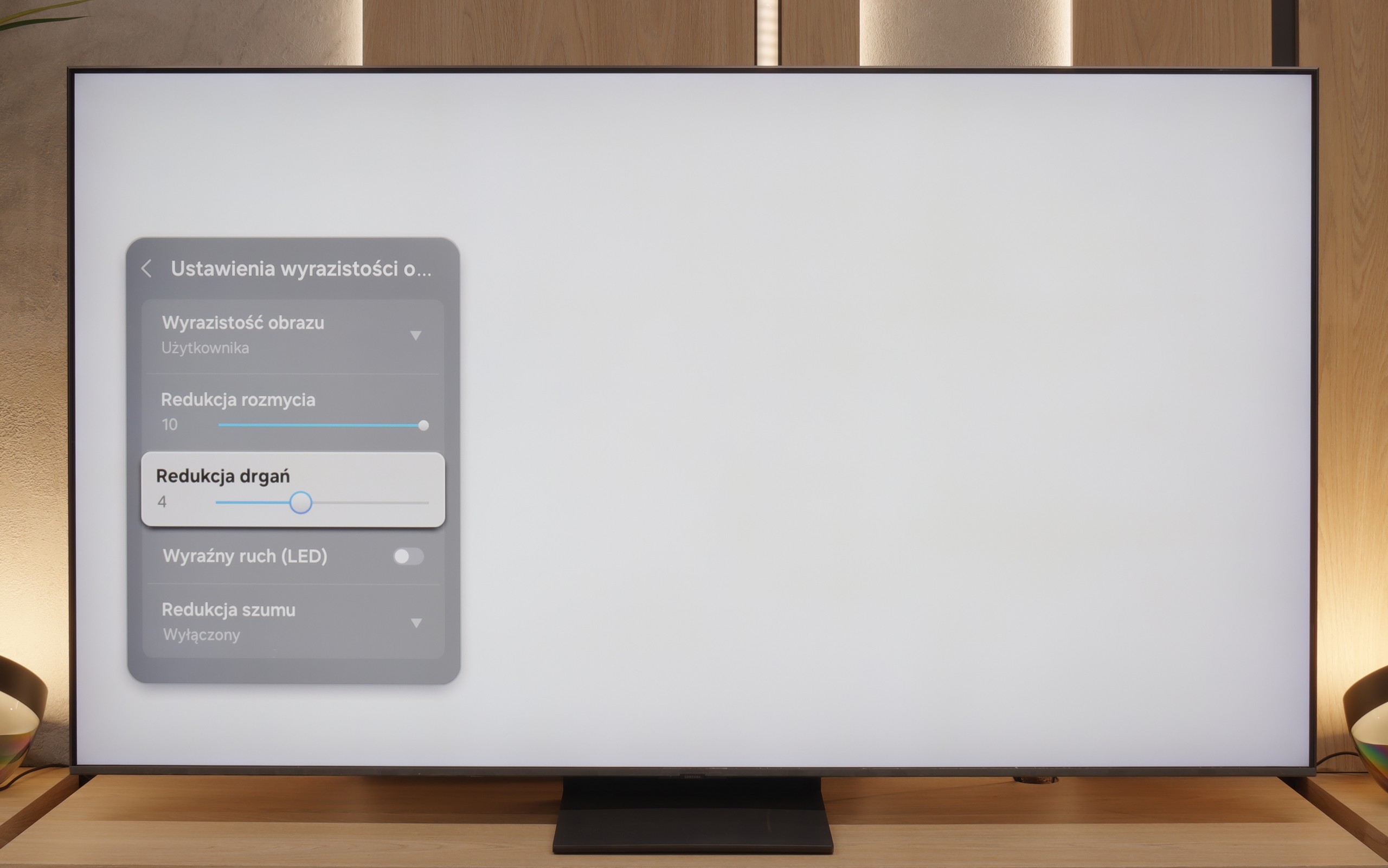

Blur (native resolution, maximum refresh rate):
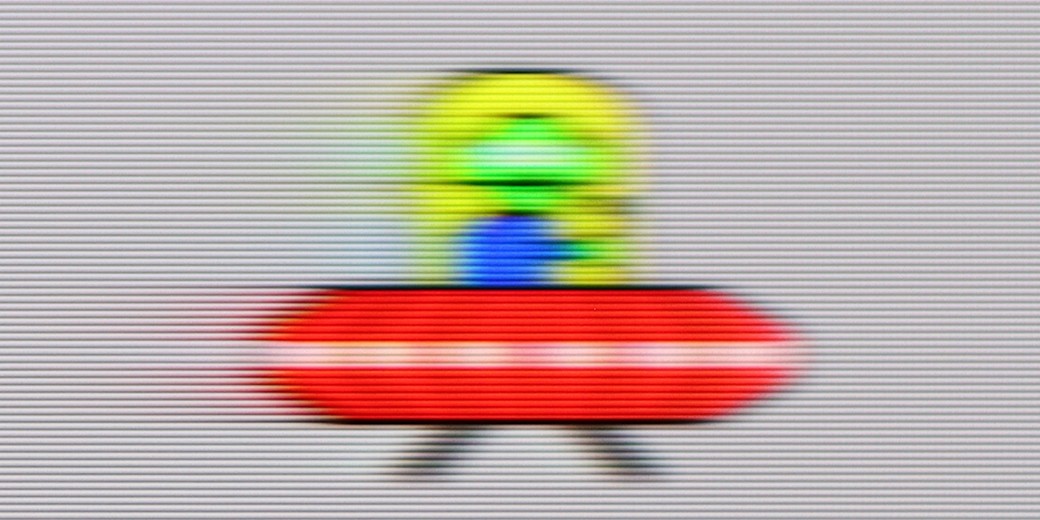
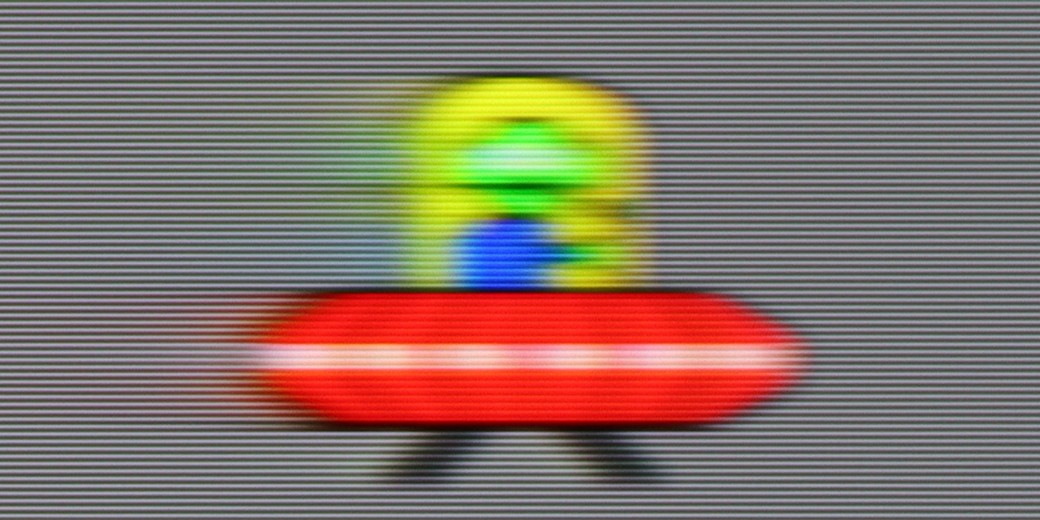
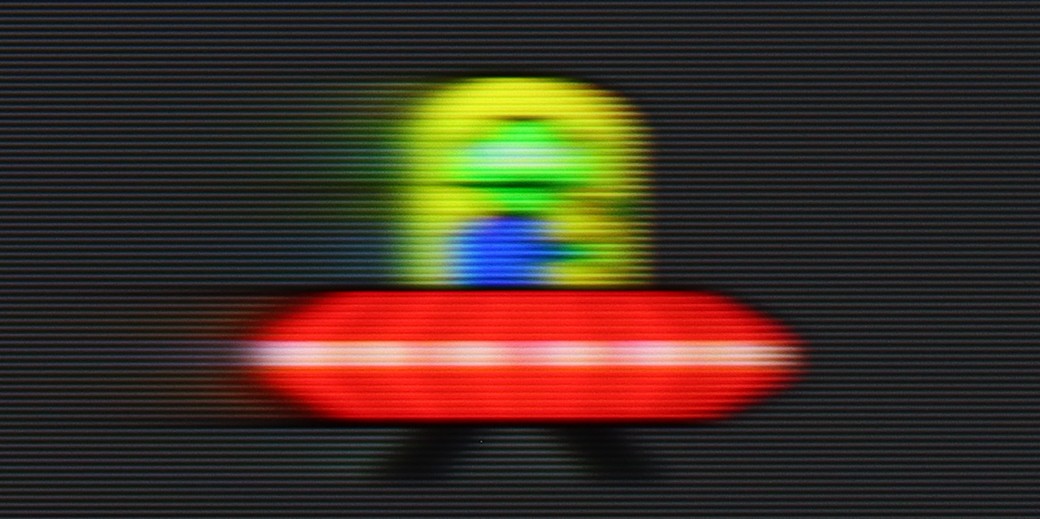



Blur (BFI function enabled):
Image flickers in this mode

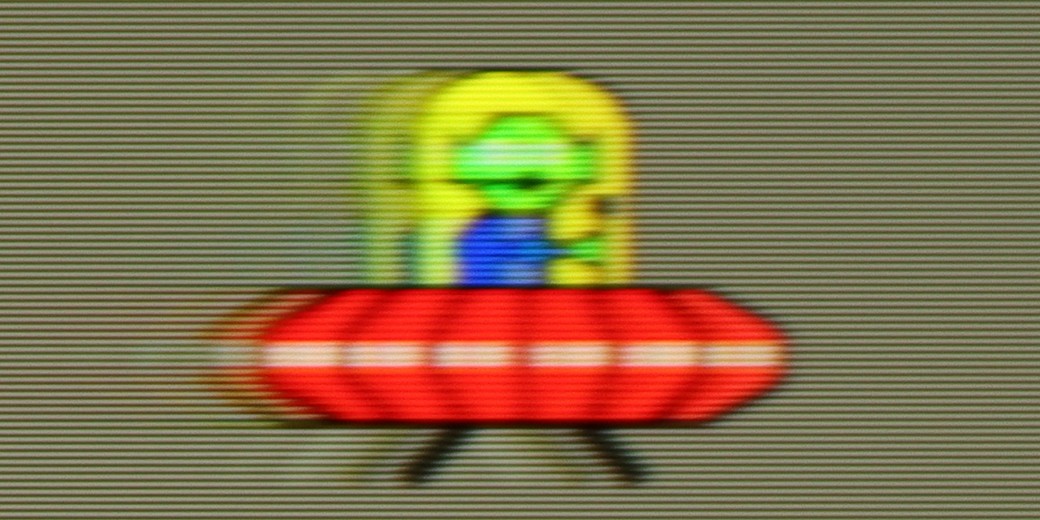

Smużenie ():
Smużenie (4K@144Hz):



QN80F is truly a "fast" television. The applied panel offers a refresh rate of up to 144 Hz, which in practice means that the screen keeps up with the action – whether we're watching a film, playing games, or browsing dynamic content online. The image doesn’t stutter, isn’t excessively smeared, and overall looks simply smooth and pleasing to the eye. Of course, the manufacturer hasn’t forgotten about cinema fans – in the settings, we’ll find an option to adjust motion smoothness, allowing us to tailor the effect to our personal preferences. We can maintain a more "framey" appearance (for those who enjoy the classic cinematic vibe) or ramp up the smoothness to a higher level for a theatrical smoothing effect. Importantly, the choice is ours. Watching films and playing on the QN80F is simply a delight.
The fluidity of motion is an area where OLEDs always shine, and the Philips OLED820 confirms this rule. The panel itself offers a refresh rate of 144 Hz, which primarily benefits PC gamers, but even with standard television sources or consoles, where it operates at 120 Hz, the motion is fast, sharp and simultaneously smooth, without signs of blurring. This is thanks to the remarkable response time between pixels, which maintains image clarity in every dynamic scene. The manufacturer has also added its own smoother called "Motion Style". In the menu, we find two sliders – the first, responsible for fluidity, allows adjustments to the number of artificially added frames in films. This way, we can choose a raw, cinematic character with a distinctly visible film frame or a more theatrical image with smooth motion. The second slider is for motion blur reduction, particularly useful in sports broadcasts. Here, we definitely recommend setting it to the maximum value, as the effect is truly excellent.
Console compatibility and gaming features
8.2/10
9.8/10
- ALLM
- VRR
- VRR range48 - 144Hz48 - 144Hz
- Dolby Vision Game Mode
- Correct implementation of HGIG
- 1080p@120Hz
- 1440p@120Hz
- 4K@120Hz
- Game bar
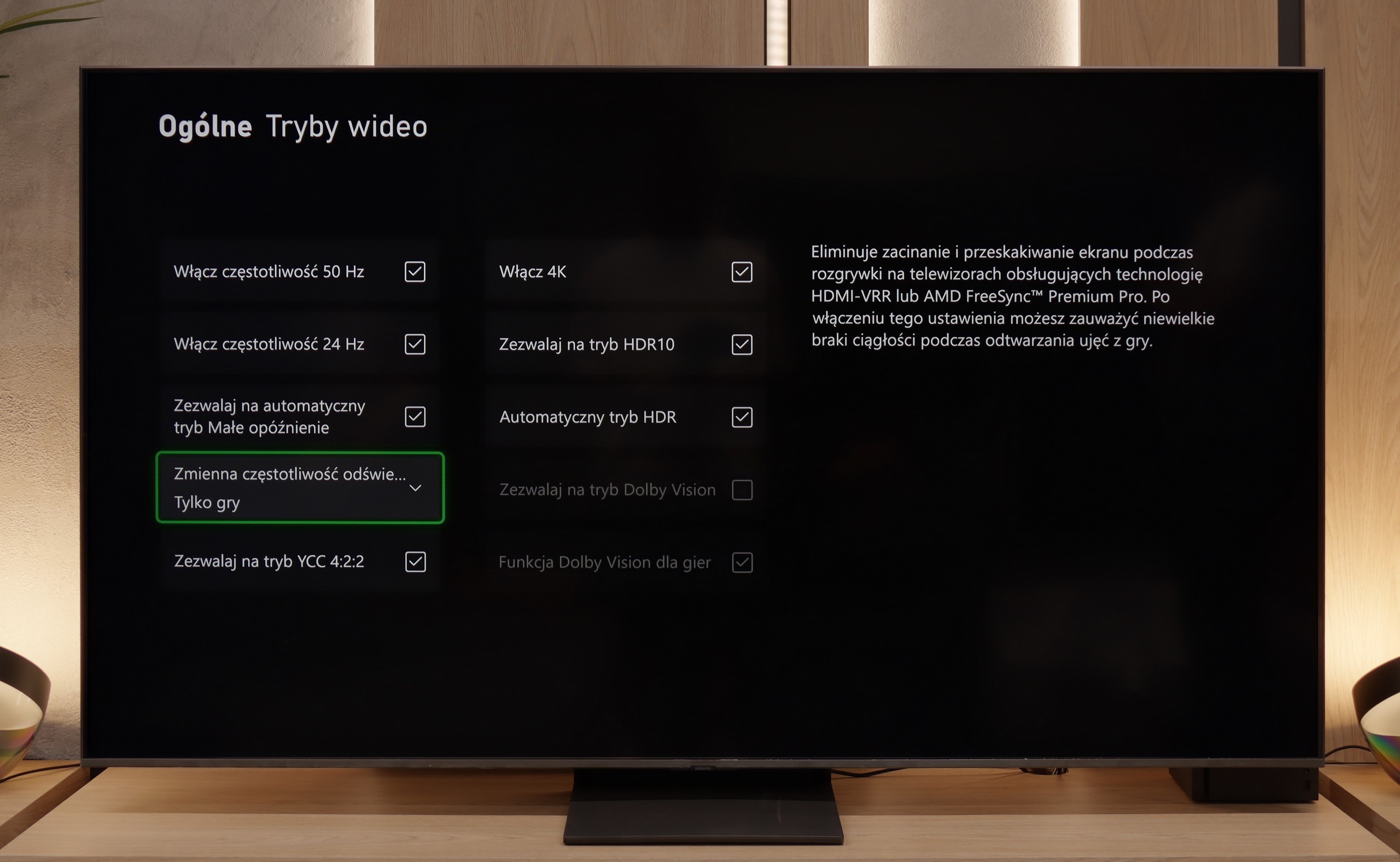

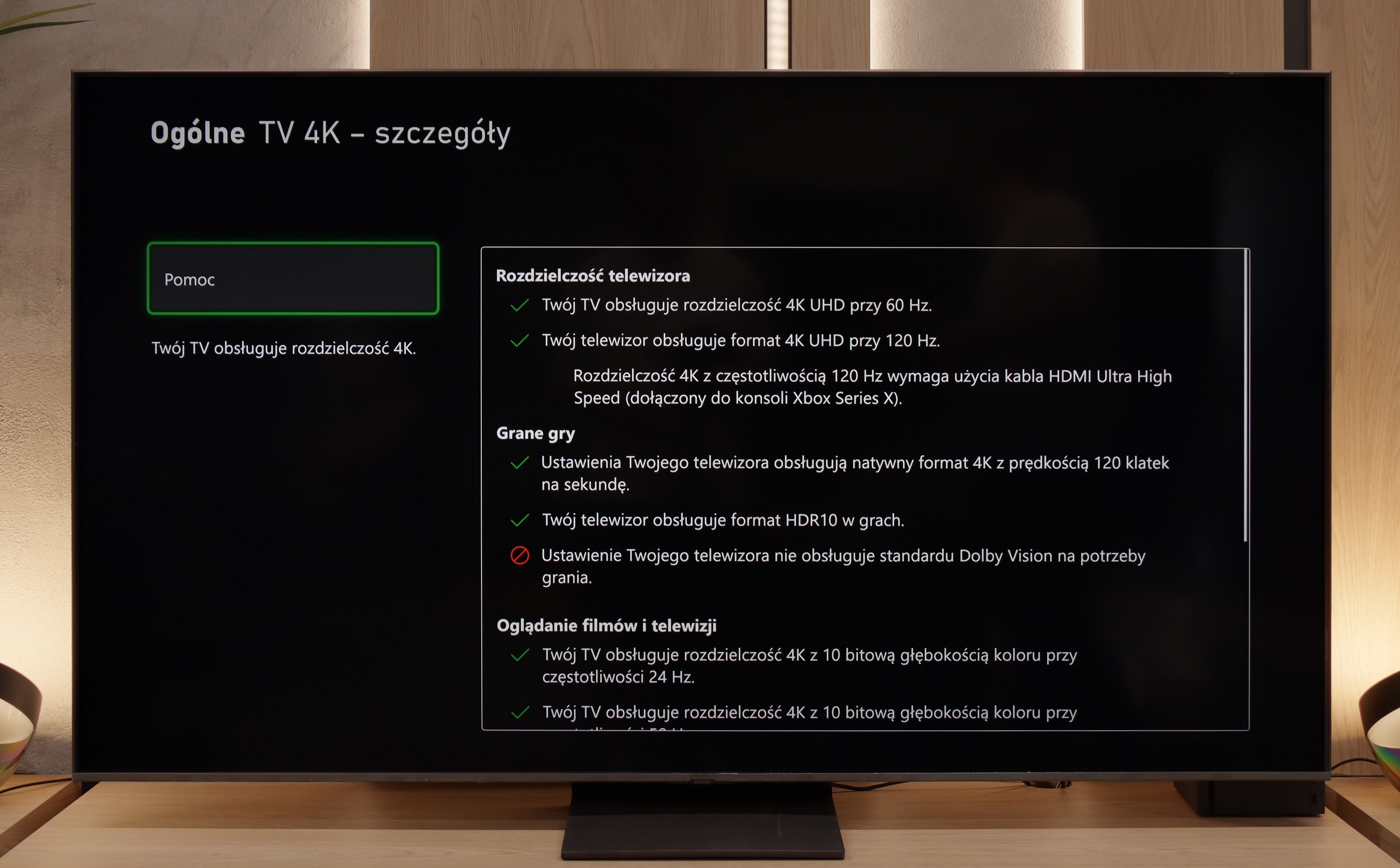

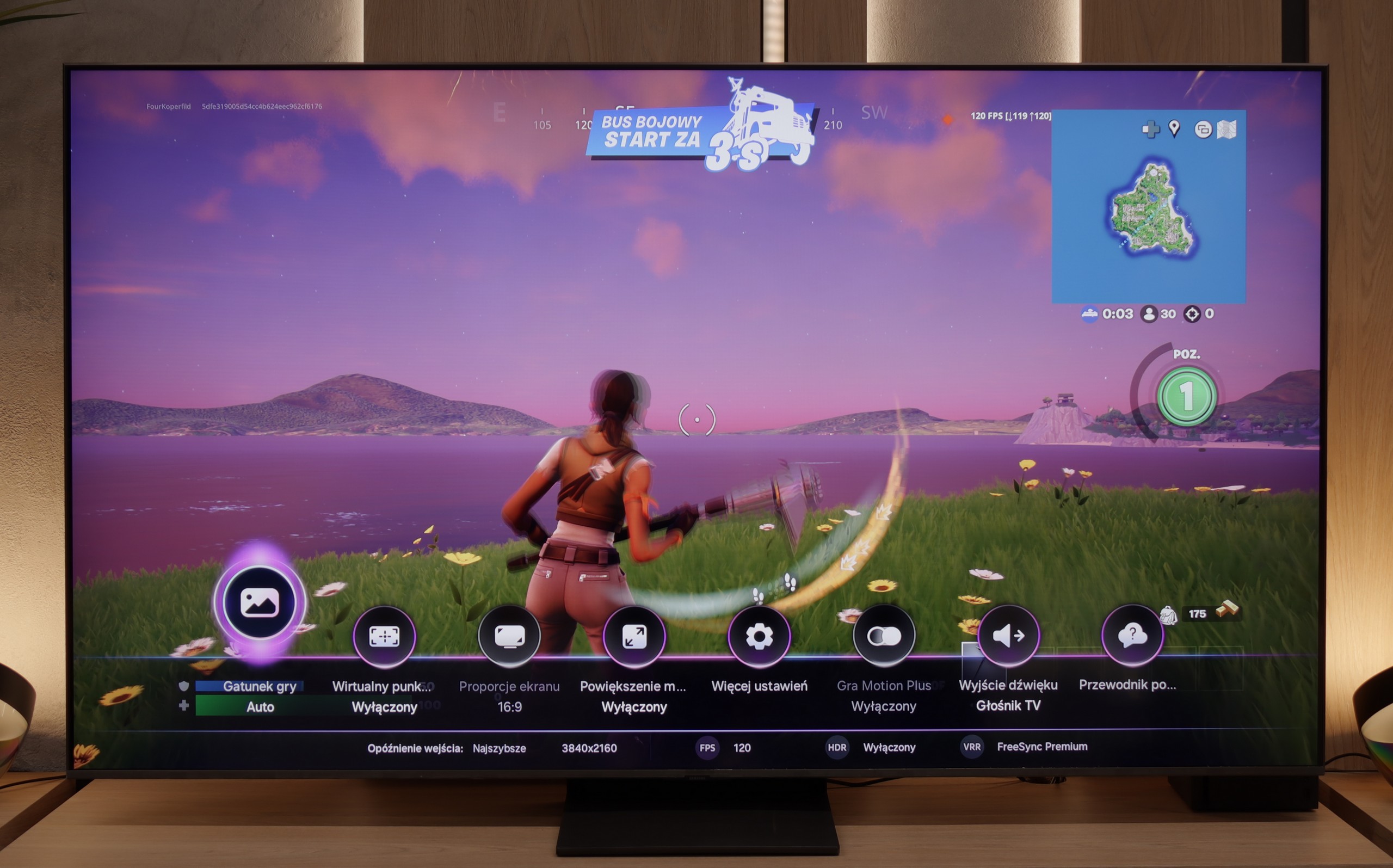

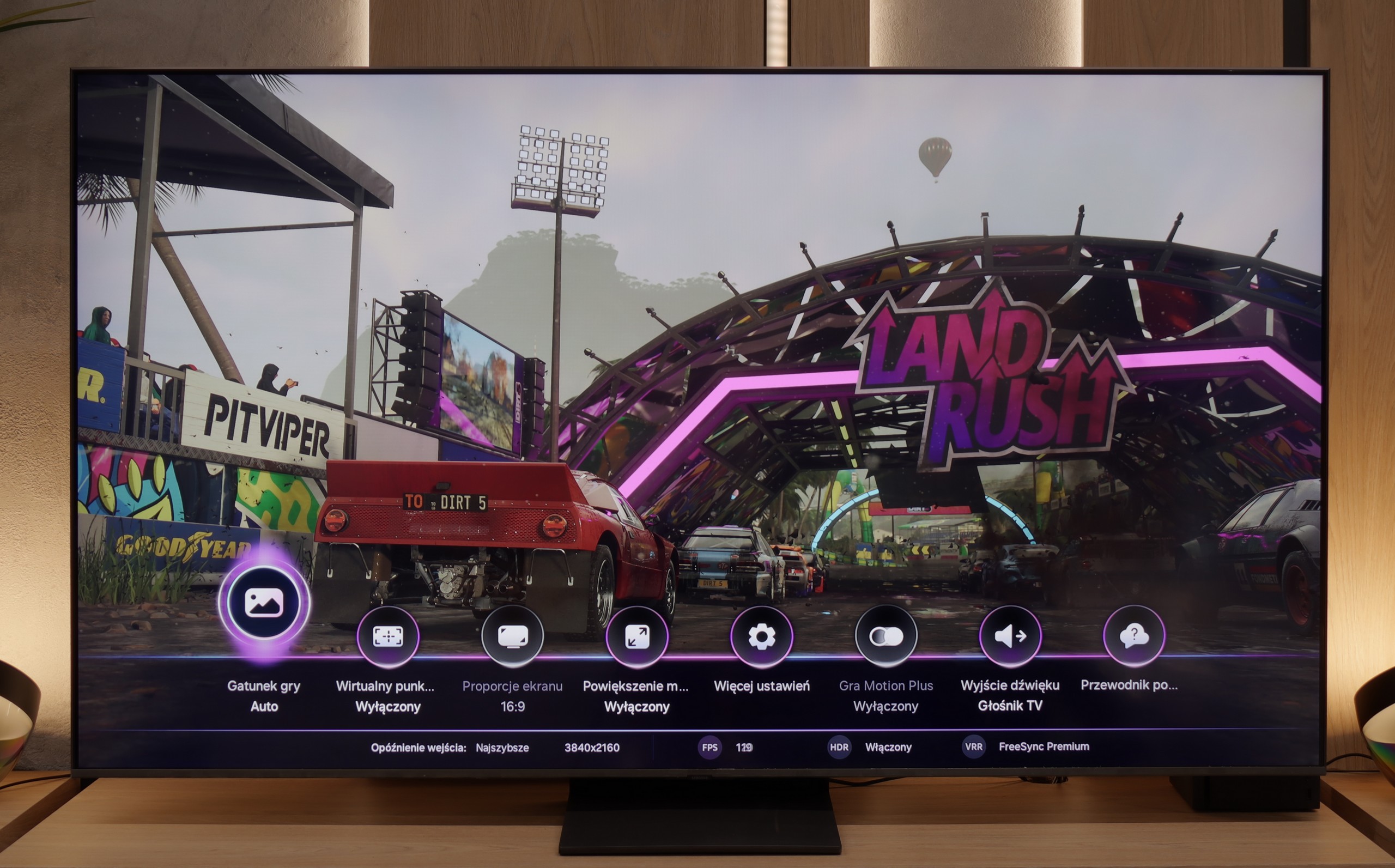

The Samsung QN80F is a television that delivers on almost every front when it comes to gaming. We have a 144 Hz panel, four full-fledged HDMI 2.1 ports, support for gamers in the form of variable refresh rate (VRR), automatic game mode (ALLM), and even one of the best-designed game bars on the market. The cherry on top is the motion smoother, which – uniquely in the world – works in games without significantly increasing input lag. Sounds like an almost perfect television for gamers? And indeed, it is almost that.
As usual, Samsung does not support Dolby Vision in games, but that no longer surprises anyone. However, it is considerably more surprising that... the HGIG function has disappeared – that is, the system that allows the console (e.g., PlayStation 5 or Xbox Series X) to precisely match HDR tone mapping to the television’s capabilities. In the latest firmware update for the 2025 models, this option has simply vanished. This looks more like a mistake than a deliberate move, but it must be noted fairly that as of the date of writing this review, the HGIG function is simply not available.
And it is precisely because of this one missing feature that the QN80F transforms from an almost perfect gaming television into a “nearly” perfect device. It’s a shame – because everything else suggested that Samsung could once again set the bar very high in this generation.
The Philips OLED820 is one of the most complete televisions for gamers. On board, we find practically everything one could expect: two HDMI 2.1 ports with full bandwidth of 48 Gbps (it's a shame there aren't four), variable refresh rate VRR, automatic game mode ALLM, support for Dolby Vision in games, and a good implementation of the HGiG mode. The television handles lower resolutions at 120 Hz with ease, so one can count on considerable flexibility when choosing different picture modes on the console. Philips also includes a Game Bar – a panel that allows changing picture modes, adding a crosshair, or previewing parameters. Although it looks rather clunky and is less polished than that of the competition, it does its job. In practice, therefore, the OLED820, in addition to a full set of four HDMI 2.1 ports, offers nearly everything a gamer could need.
Input lag
9.8/10
10/10
SDR
HDR
Dolby Vision
The QN80F does not disappoint when it comes to response time. The input lag for 120 Hz content drops below 10 ms, which can be considered an almost perfect result – it is hard to expect more in this class of TVs. Gaming is smooth, responsive, and without delays that could annoy even the most sensitive players. For 60 Hz materials, the lag is higher, around 19 ms, but this is a completely natural phenomenon and still falls within comfortable limits.
The input lag on the Philips OLED820 is truly at a reference level. Measurements showed values below 5 ms, placing it among the absolute top televisions available on the market. Even the Dolby Vision mode does not pose any problems in this regard, which is quite a rare phenomenon. In practice, this means lightning-fast response to every movement, no noticeable delays, and complete comfort in dynamic games. In short, superb results that will delight even the most demanding gamers.
Compatibility with PC
8.8/10
6.5/10
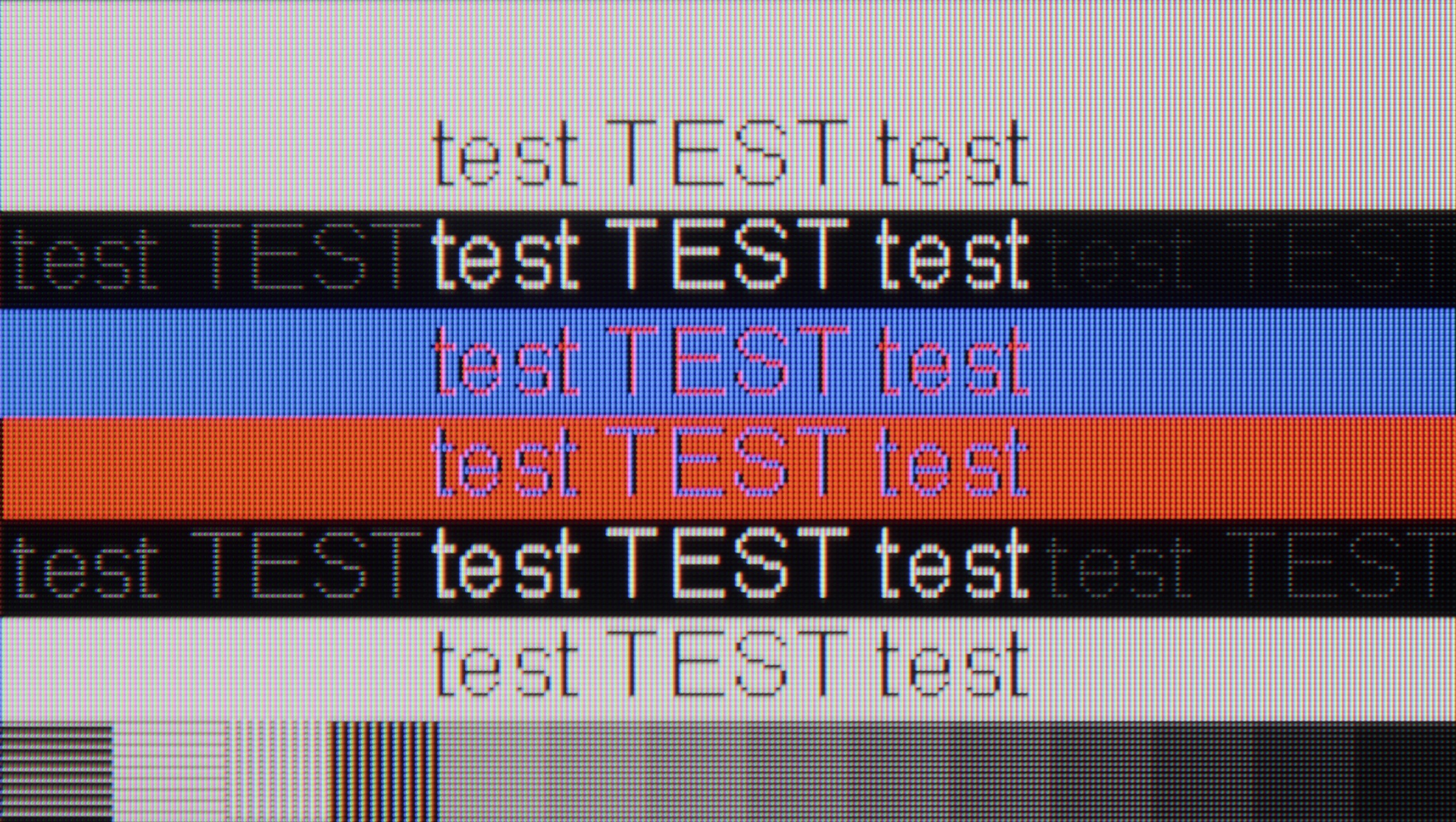

Playing on the QN80F with a connected computer is pure pleasure. The television effortlessly works with NVIDIA graphics cards (thanks to G-Sync support) and AMD (thanks to FreeSync Premium), and the 144 Hz refresh rate only enhances comfort during dynamic gameplay. Everything works immediately, without unnecessary fiddling with settings – exactly as it should.
When it comes to work, it is also very good. The readability of fonts is at a high level, and texts appear sharp and clear. With very thin horizontal lines, some minor imperfections in shading can be noticed, but honestly – you really have to look closely. Unless, like us, you sometimes enjoy looking at the screen with a magnifying glass… then you might spot something 😉.
Cooperation with a PC in the case of the Philips OLED820 varies depending on the application. For gaming, it performs exceptionally well: a high refresh rate of 144 Hz combined with G-Sync support provides the smoothness and responsiveness that other televisions can envy. The situation is less favourable when it comes to text work. The lack of proper implementation of chroma 4:4:4 causes fonts on coloured backgrounds to appear slightly blurred, which significantly reduces work comfort. Therefore, it's hard to recommend the OLED820 as a screen for office work with text or numbers. It's a shame the manufacturer hasn't learned from last year's models and this flaw continues to be repeated.
Viewing angles
3.1/10
7.6/10
QN80F, like most TVs with a VA panel, does not impress in terms of viewing angles. All it takes is a slight lean to the side to notice a significant drop in brightness and lost colour saturation. The picture loses its "depth" and "vibrancy", and darker scenes may appear slightly washed out. However, this is a typical characteristic of VA panels, which provide significantly better native contrast than IPS panels in return. In short: something for something. If you are sitting directly in front of the screen, there will be no problem. But when watching together in a larger group, it is worth keeping this in mind.
The viewing angles in the Philips OLED820 are another advantage that should please you. OLEDs have always been characterised by almost perfect angles, so regardless of where we look from, the image remains clear and legible. Indeed, the classic WOLED matrix does not compare to technologies like MLA OLED or QD-OLED, but it's still hard to find fault here. The angles are simply excellent.
TV efficiency during daytime
6.6/10
5.7/10
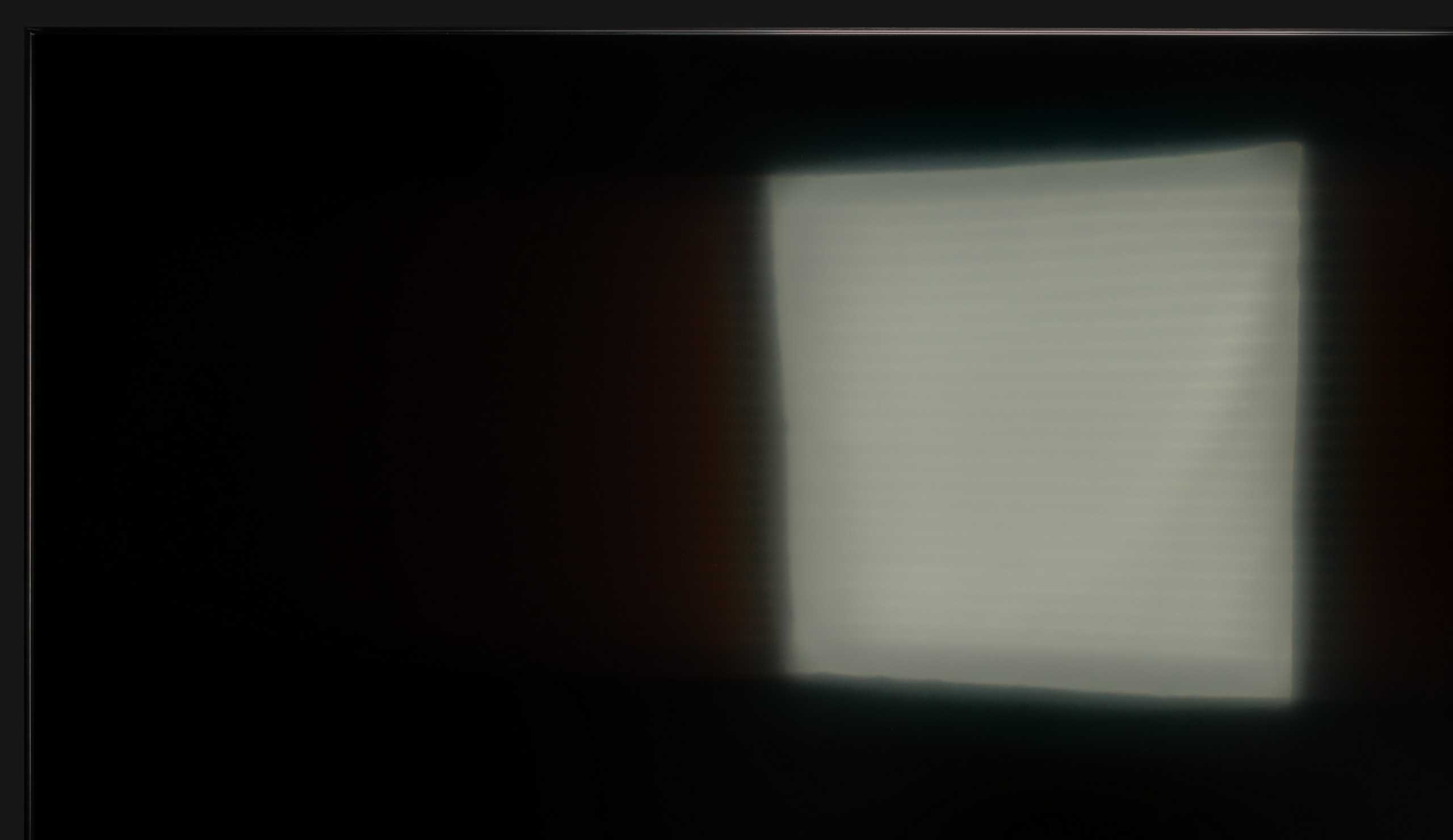

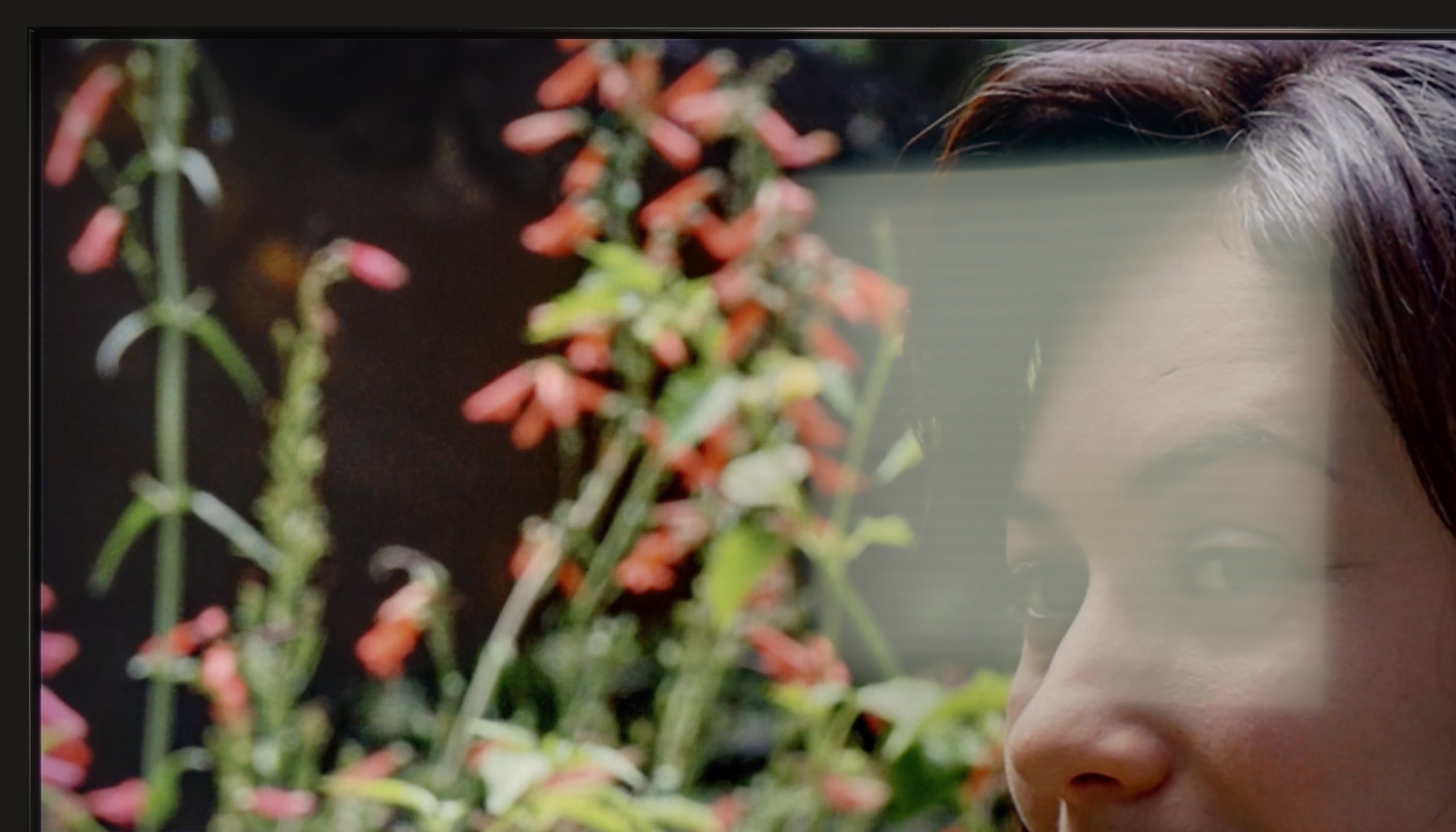

Matrix brightness
Average luminance SDR
Philips OLED820: 345 cd/m2
Samsung QN80F: 543 cd/m2
The QN80F is truly a bright television. The average brightness in SDR content is around 550 nits, regardless of the scene, which in practice means that you can comfortably watch content even in a well-lit room – and you don’t have to close the blinds every time you turn on a film. The new satin coating on the panel also deserves praise, as it performs significantly better at reducing reflections compared to last year’s QN80D. Glare is less bothersome, and the screen maintains readability in various lighting conditions. It’s hard to find fault here – the QN80F performs simply excellently during the day.
Details about the matrix
Subpixel Structure:
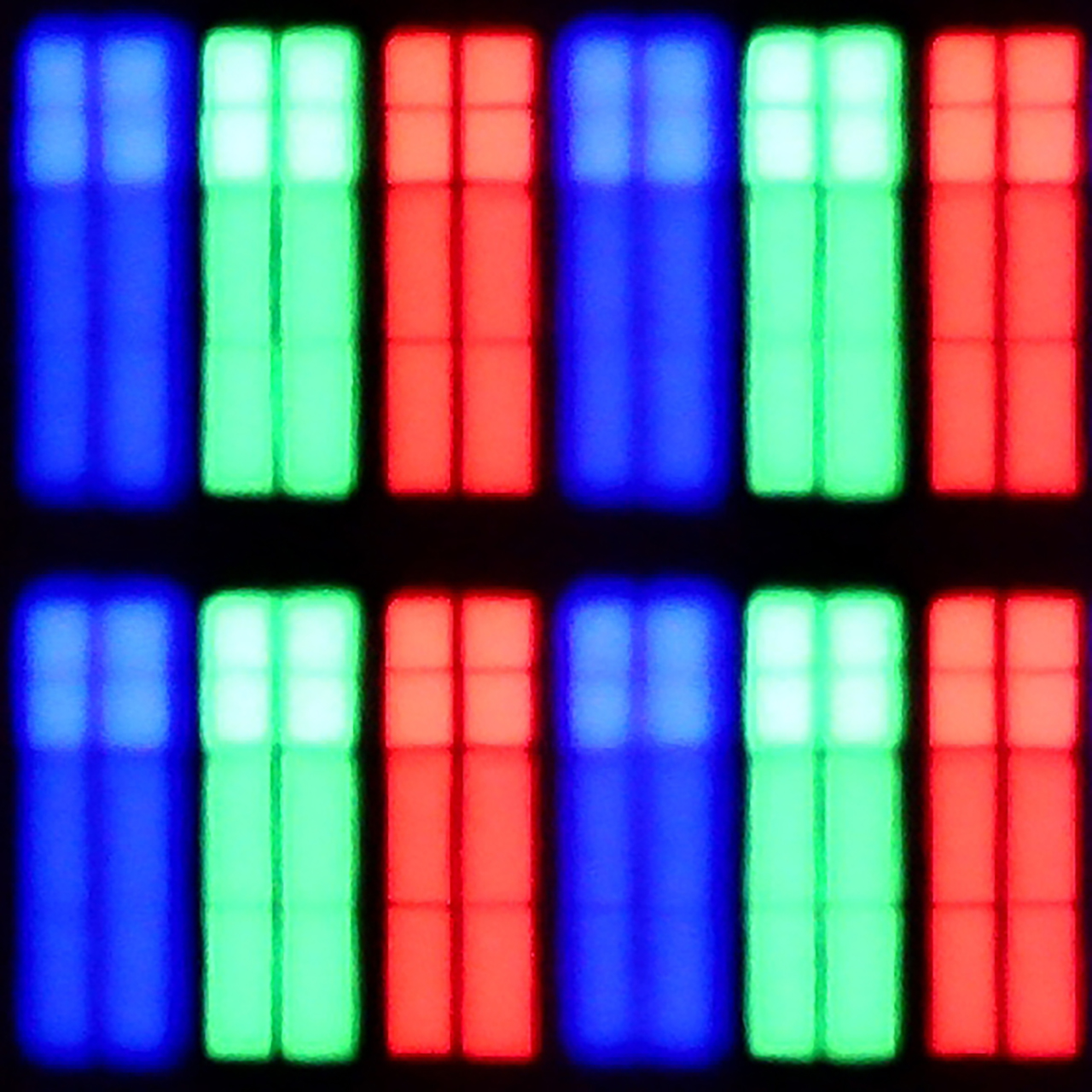
Panel uniformity and thermal imaging:
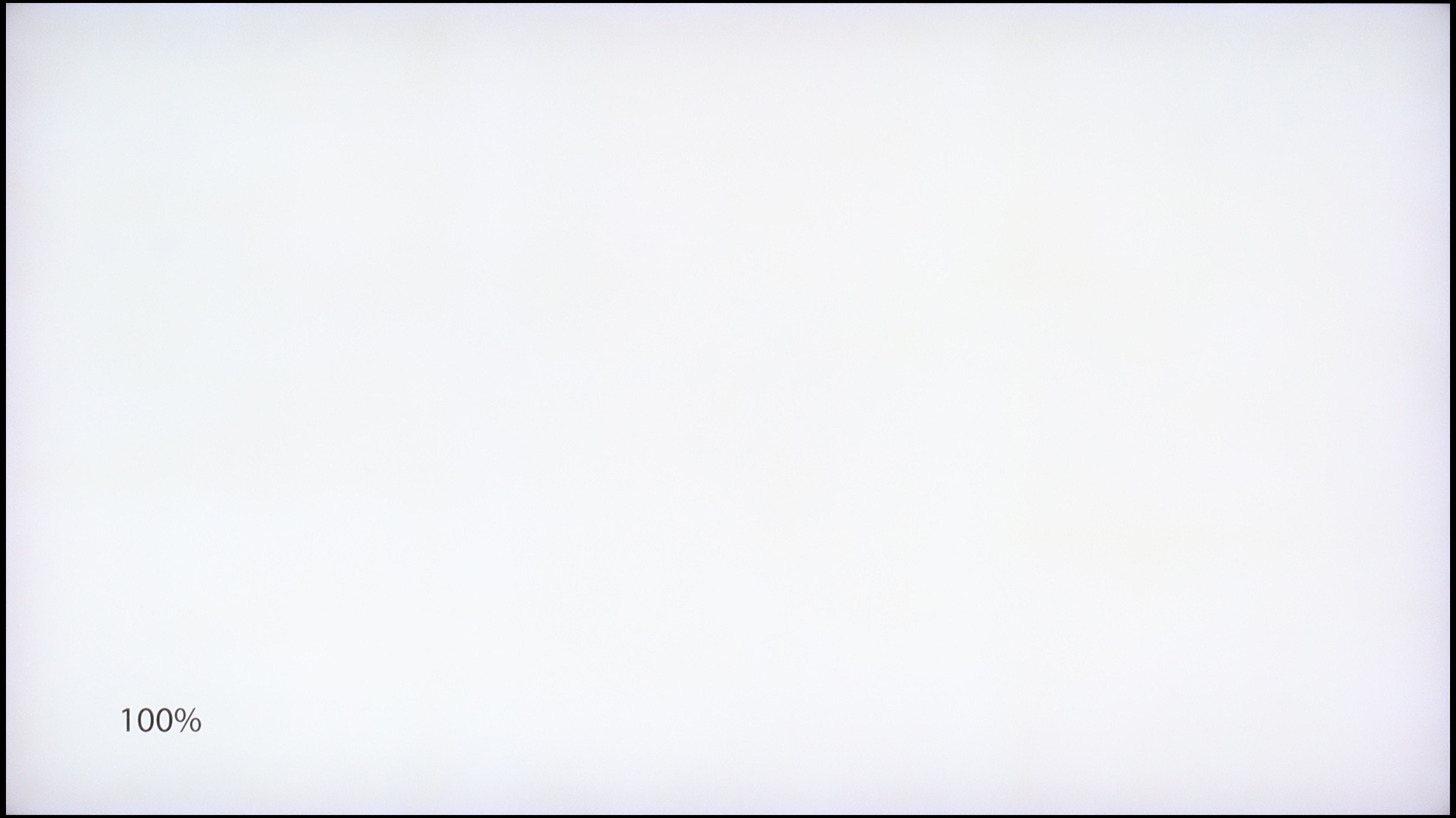

TV features
7.7/10
6.8/10
- HDMI inputs0 x HDMI 2.0, 4 x HDMI 2.1 48Gbps2 x HDMI 2.0, 2 x HDMI 2.1 48Gbps
- OutputsToslink (Optical audio), eARC (HDMI), ARC (HDMI)Toslink (Optical audio), eARC (HDMI), ARC (HDMI), Mini-Jack (Headphones)
- Network InterfacesWi-Fi 2.4GHz, Wi-Fi 5GHz, Ethernet (LAN) 100MbpsWi-Fi 2.4GHz, Wi-Fi 5GHz, Ethernet (LAN) 100Mbps
- TV receptionDVB-T, DVB-T2, DVB-S, DVB-S2, DVB-CDVB-T, DVB-T2, DVB-S, DVB-S2, DVB-C
Classic features:
- Recording to USB (terrestrial TV)
- Recording programming
- Picture in Picture (PiP)
- RF remote control (no need to aim at the screen)
- Backlit remote control
- Teletext
- Audio only mode
- Bluetooth headphones support
- Simultaneous Bluetooth headphones & TV audio
Smart features:
- AirPlay
- Screen mirroring (Windows Miracast)
- Wyszukiwanie głosowe
- Voice search in native language
- Ability to connect a keyboard and mouse
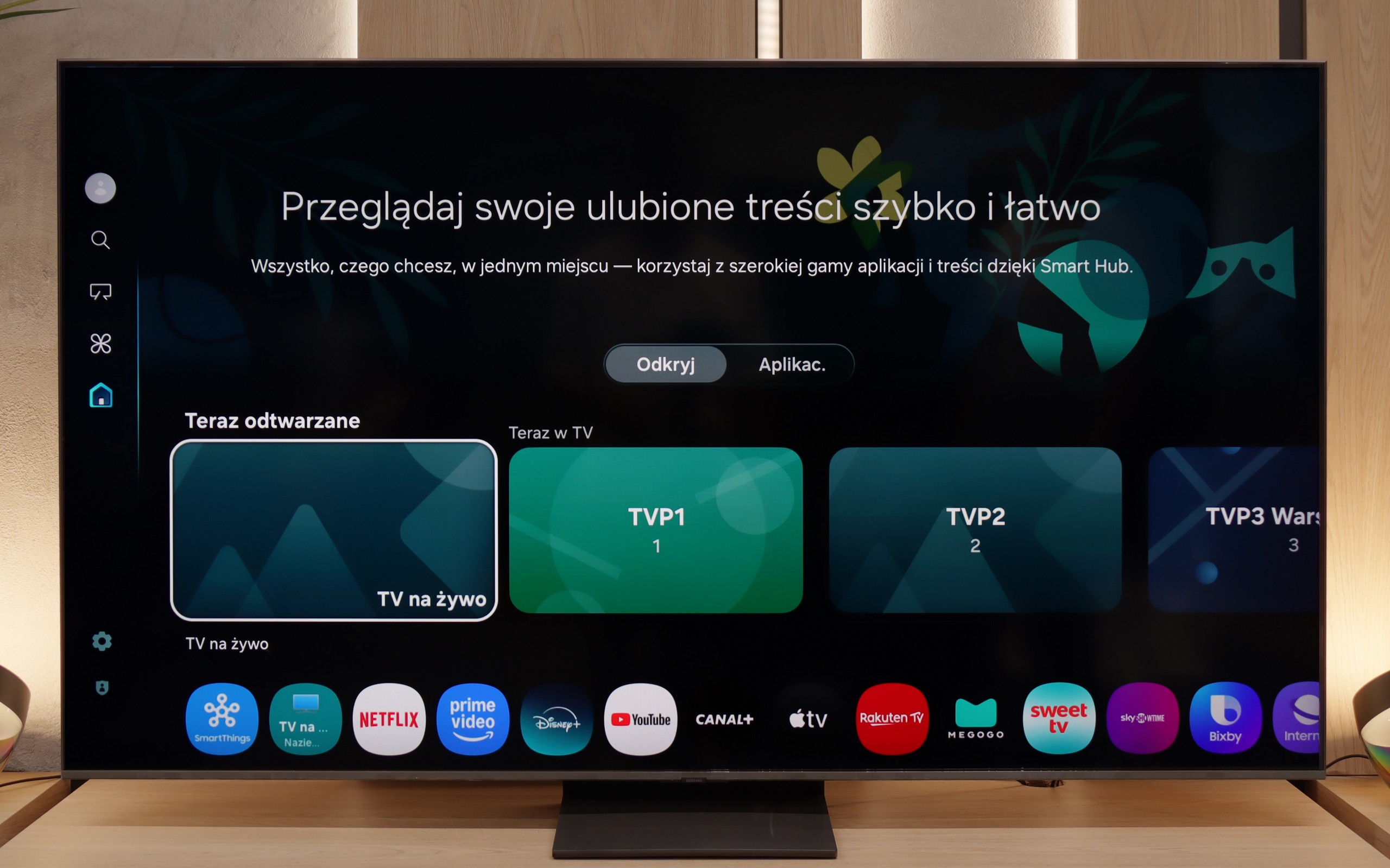
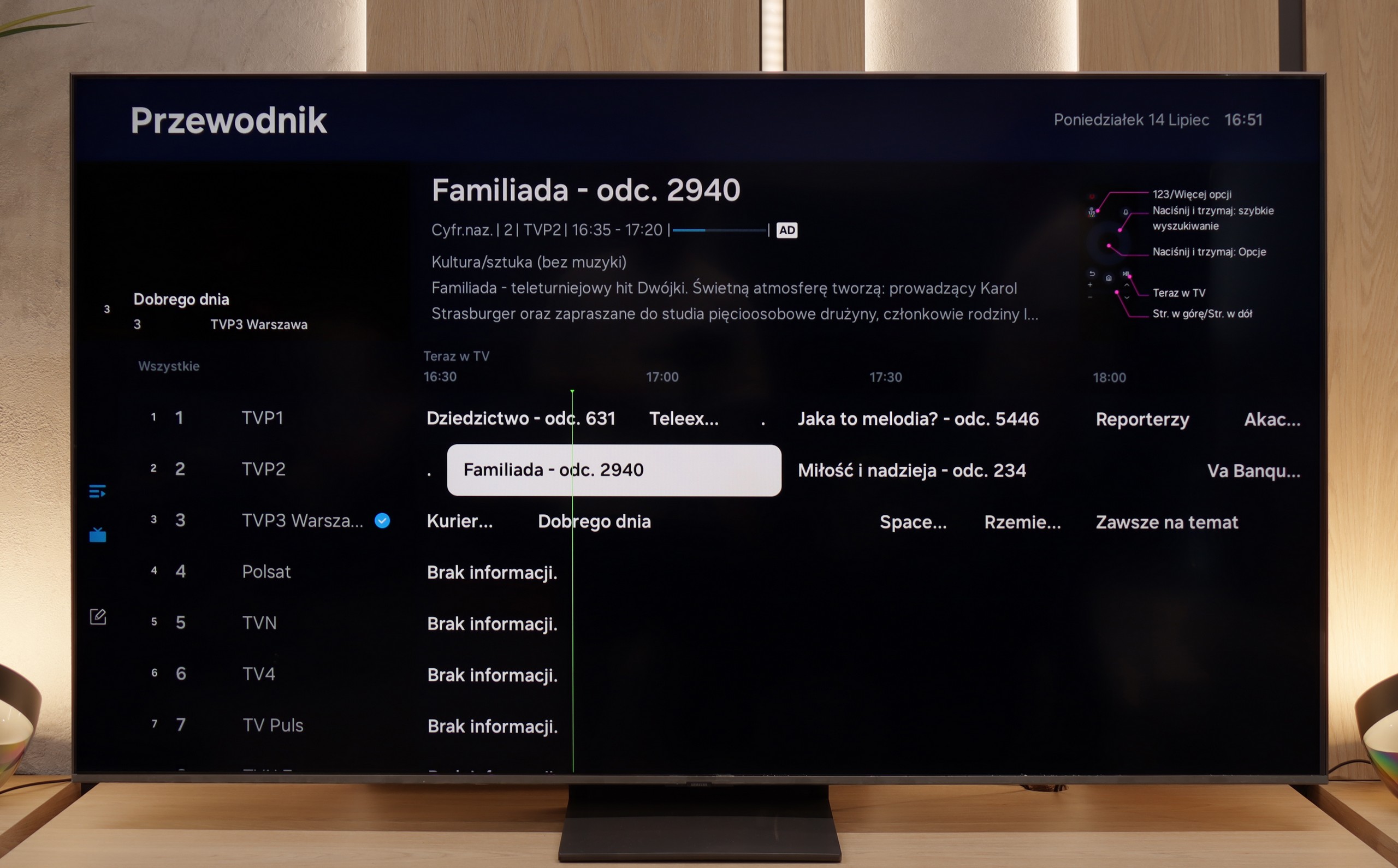
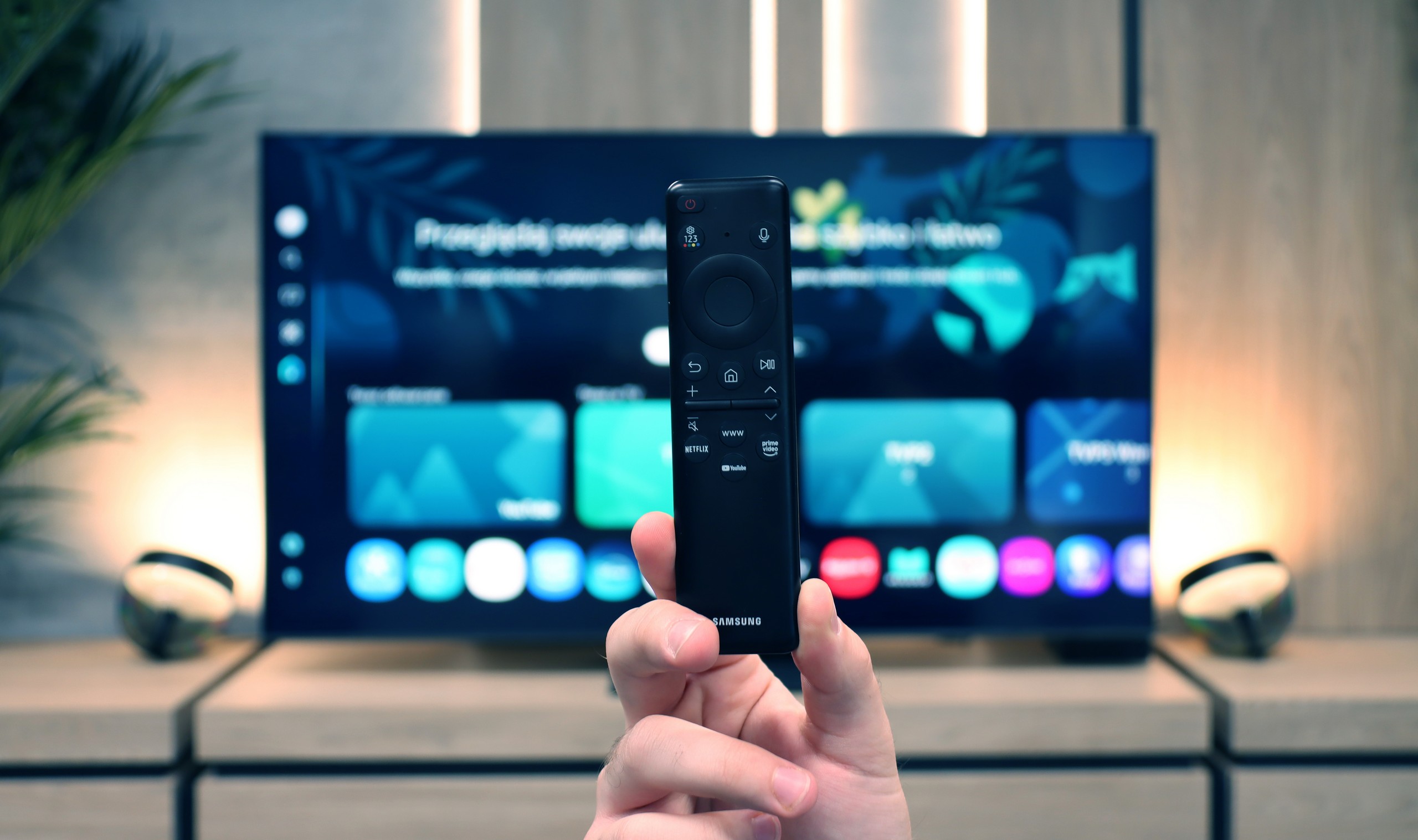
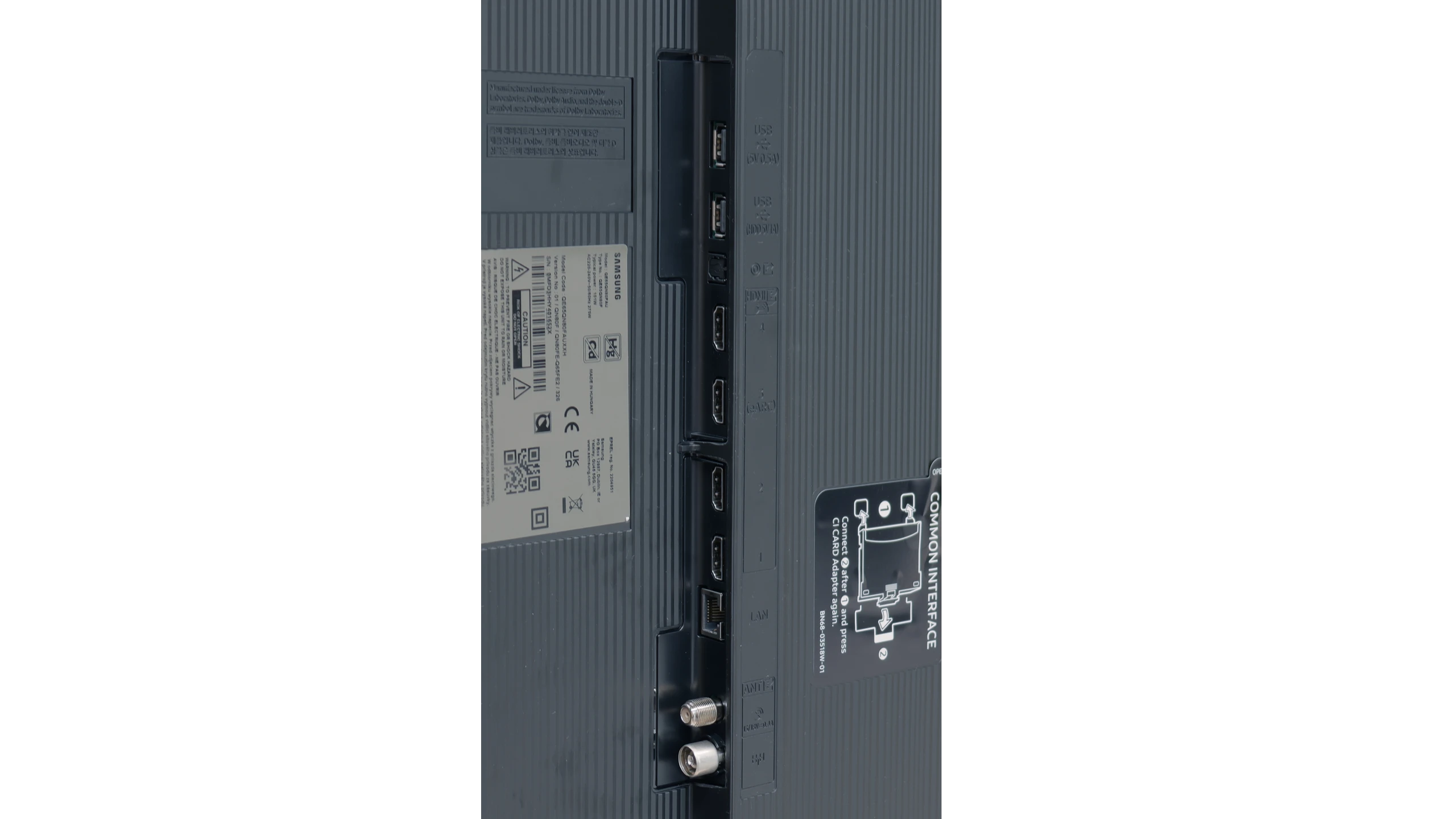




SmartTV QN80F: Tizen
In terms of smart features, the QN80F has nothing to be ashamed of. On the contrary – Tizen is one of the richest operating systems when it comes to functionality. We have voice search, support for AirPlay, Miracast, and all the major streaming platforms at our fingertips. But Samsung's true advantage reveals itself in the smart home – SmartThings. Here you can not only synchronise light bulbs and vacuum robots but also integrate devices from other manufacturers, thanks to support for the Matter standard. And suddenly it turns out that the QN80F can serve as a home command centre. There is just one "but" – Tizen is a closed system, so we may not find a few lesser-known applications. Although in practice it has everything that 99% of users need.
Classic TV features:
When it comes to classic features, it is just as good – well, almost. The QN80F supports picture-in-picture, which is a rarely seen but still useful PiP function. We can easily find the EPG, good old teletext (yes, it works!), and the ability to connect external devices via Bluetooth – whether it's headphones or a soundbar. Unfortunately, there is a lack of the option to record to USB from the built-in tuners. This is a minor setback, especially since the competition at a similar price increasingly offers this feature. It may not be a must-have function, but since everything else works so well, it's a pity that this feature is missing a dot over the i.
GoogleTV on OLED820
Philips OLED820 runs on the Google TV system, which immediately places it among televisions that truly offer user freedom. It’s a fantastic platform that needs no introduction – it boasts almost an endless number of applications, from popular VOD services to niche programmes or games. Google TV also allows you to personalise the home screen, tailoring content to our preferences, so the television actually “learns” our viewing style. A significant advantage is also the voice assistant from Google – fast, natural, and effective. It can understand even less obvious questions, and in practice, it works much better than many competitors. Unfortunately, there was a hiccup – the screen mirroring feature simply did not work during testing. This can be considered a minor issue, but in 2025, such things simply shouldn’t happen.
Classic Features of OLED820
When it comes to classic additions, the OLED820 does not try to play conservative notes. On one hand, we get a backlit remote control with a numerical keypad that is quite well organised and easy to use. On the other hand – you have to aim it at the screen, as it operates on infrared, which is more reminiscent of equipment from a decade ago than a modern television. It also lacks some features that are often found in competitors – there is no USB recording from tuners or a PIP mode. A nice touch among the classic solutions is the analogue mini-jack headphone input. This is rare today and could prove useful – whether for a senior with an additional headphone station or for someone who would like to connect older speakers.
AmbilightTV OLED820
One cannot overlook Ambilight, which is a hallmark of Philips. This solution impacts not only the appearance of the television but also the reception of content. The illumination system can be set up in various ways, from a multi-coloured mode that dynamically tracks the image to calmer, static backlighting. We definitely recommend the latter option, as the gentle light behind the screen makes the content being watched, combined with the OLED matrix, look even deeper and more engaging. It’s a simple yet very effective addition that has given Philips televisions character for years.
Playing files from USB
9/10
9.5/10
Supported photo formats:
Maximum photo resolution:
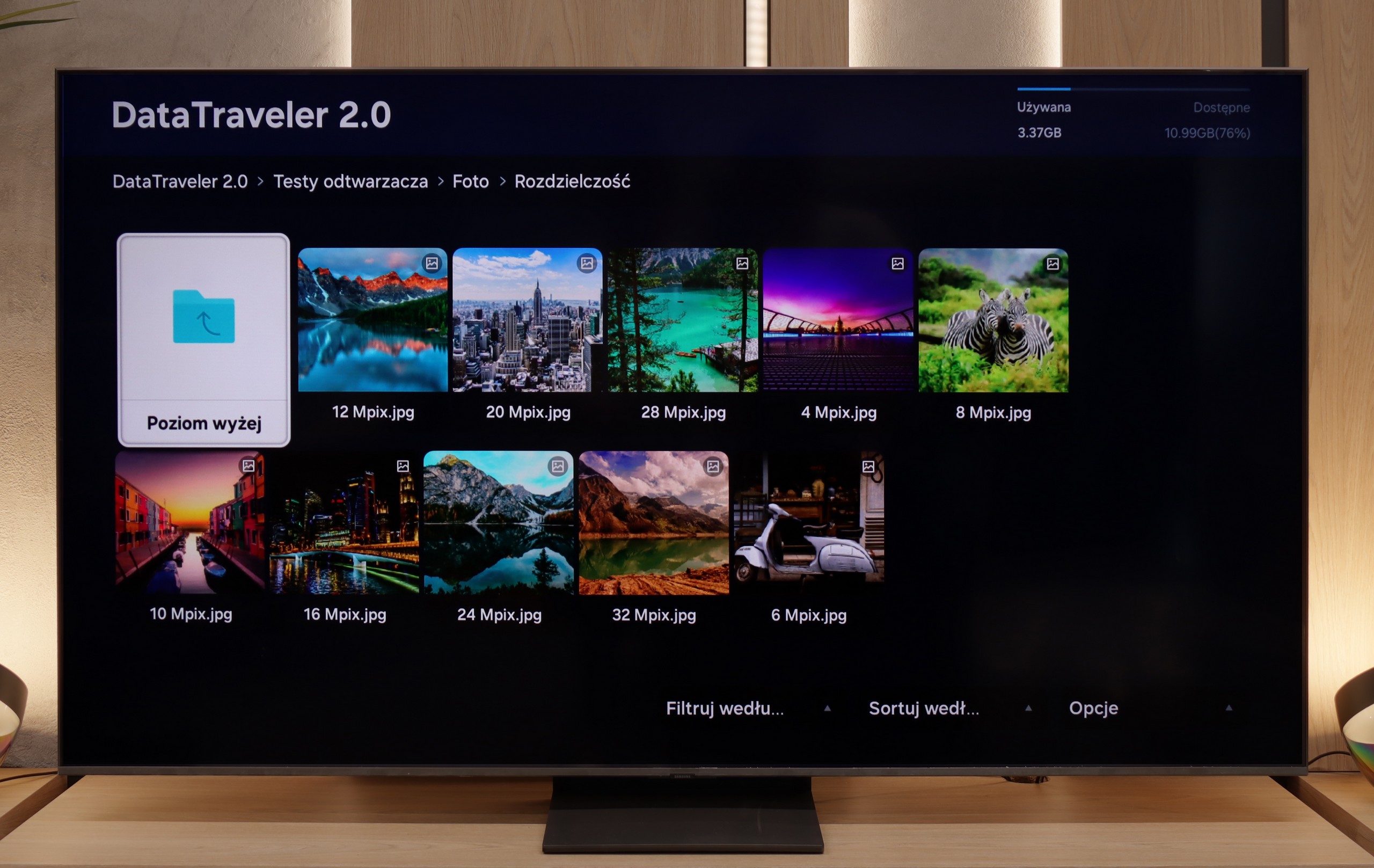

The built-in media player in the QN80F handles most popular video formats – from classic MP4 to slightly more demanding containers. It may not be a powerhouse like VLC, but it's perfectly adequate for home use. The situation is less impressive with photographs – here, unfortunately, it's rather modest. Support is mainly limited to the JPG format, but hey, at least that's the most important one 👌. During our tests, there was also a slight issue with subtitles. The QN80F could only handle the simple text format .txt – other, more advanced formats (like .srt or .sub) were unfortunately not recognised.
The Philips OLED820 has a built-in file player with USB, which at first glance looks quite clunky, but in practice works surprisingly well. One could even say that it is one of the best built-in players available in televisions. It handles practically every type of file: photos, videos or music, with a few minor exceptions that most of the competition does not support either. And if someone still feels like something is missing, there is always the option of installing the VLC application from the Google Play library, and the problem disappears.
Apps
8.7/10
9.6/10














































Sound
6.7/10
7.7/10
- Maximum volume87dB81dB
- Dolby Digital Plus 7.1
- Dolby True HD 7.1
- Dolby Atmos in Dolby Digital Plus (JOC)
- Dolby Atmos in Dolby True HD
- DTS:X in DTS-HD MA
- DTS-HD Master Audio
For a television of this class, the QN80F sounds surprisingly good. It supports the Dolby Atmos format, which is worth noting, as this is still not a given in many models in this range. Unlike the thinner QN70F, here you can even feel a slight bass – all thanks to the thicker casing, which simply provides more space for the sound to "breathe." It's perfectly adequate for everyday viewing and series, and with the right settings, one can even be tempted to listen to music without the need for external equipment. However – as is often the case with Samsung, there is unfortunately a lack of support for the DTS:X format, so if we are using audio devices that support this format, we will first need to connect them to the amplifier and only then to the television.
The Philips OLED 820 features a built-in 4.1 speaker system with a total power of 70 W. At the back of the casing is a subwoofer, which is responsible for quite solid and deep bass. The classic speakers responsible for the rest of the range are located at the bottom of the television, which means that the sound does not always spread in the way we would want. However, the overall sound can be considered acceptable – series, television programmes, or occasional music listening are satisfactory, with a slight bass support. This should be sufficient for daily use, although we still recommend purchasing even an inexpensive soundbar, which will significantly improve the user experience.
Acoustic Measurements
87dBC (Max)
75dBC
81dBC (Max)
75dBC


